 Walks and other things
Walks and other things
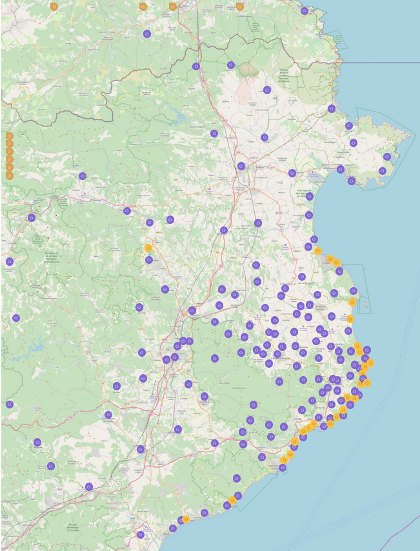 One of the joys of the Costa Brava is the variety of landscapes and we like to visit places and walk (a lot), particularly into and around the Gavarres. Sometimes we travel around on bike. In the summer, we swim and canoe.
One of the joys of the Costa Brava is the variety of landscapes and we like to visit places and walk (a lot), particularly into and around the Gavarres. Sometimes we travel around on bike. In the summer, we swim and canoe.
These then are write ups of walks, hikes and activities that we've done since November 2012, with photos straight from the original walk or activity.
We like to make circular walks and our walks range in length from about 4km (an hour) to around 16km (four hours) - but probably about 2 1/2 hours on average - though if you want to reduce the length, there are usually shortcuts.
To find walks by location, click on the map, which goes to a full sized map with links to individual walks and visits. To our surprise, we were listed in the Sunday Times' Essential Costa Brava (Feb 2017).
The most visited walks are:
- Calella de Palafrugell/Cap Roig to Castell - classic wild Costa Brava
- Far de Sant Sebastia (Llafranc) to Tamariu
- Platja d'Aro and S'Agaro
- Sa Tuna, Cap de Begur, Begur
- Eulogy to the Ruta del Tren Petit (Palafrugell, Palamos, Mont-ras and Vall-llobrega)
- Fornells and Aiguablava walk (GR92)
- Mont-ras to Calella de Palafrugell and Llafranc
- Platja de Castell and La Fosca
- St Antoni de Calonge, Torre Valentina to Platja d'Aro (almost)
- Escala, St Marti d'Empuries and beyond
- Bell-lloc and Castell de Vila-Roma (Palamos)
- Platja Sant Pol to Sant Feliu de Guixols
- Roses - Canyelles beaches to Cap Falconera
- Blanes, Lloret de Mar, Tossa de Mar by GR92
Brunyola
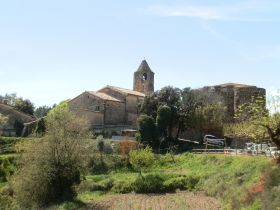 As we had to be at Girona Airport at the weekend, we looked for a walk nearby and found the village of Brunyola just off the main road to Vic. Brunyola is a tiny hamlet sitting on top of an isolated hill with views all around; south to Montseny, out towards Cassa de la Selva and the Gavarres to the east, and of course views to the hinterland of Girona and the Pyrenees. The village itself is barely more than 30 houses, but has a castle, church, restaurant and children's colonies auberge and for time we were there, it seems quite a number of visitors who had come in for Sunday lunch.
As we had to be at Girona Airport at the weekend, we looked for a walk nearby and found the village of Brunyola just off the main road to Vic. Brunyola is a tiny hamlet sitting on top of an isolated hill with views all around; south to Montseny, out towards Cassa de la Selva and the Gavarres to the east, and of course views to the hinterland of Girona and the Pyrenees. The village itself is barely more than 30 houses, but has a castle, church, restaurant and children's colonies auberge and for time we were there, it seems quite a number of visitors who had come in for Sunday lunch.
Access to the village is pretty much one road in and one road out so you have to come from the west off the C-63 road. Driving into the centre the few streets that are below the church are full of cars with visitors who have come for the local restaurants. So we park just around the corner on a patch of rough ground that looks out towards the airport plain. The village stands above the plain for the airport and we can look out towards Girona in one direction, or turn and look towards the mountains in other directions.
We firstly walk up to the church and then around the corner to the conjoined castle which looks more like a private house now. The hamlet only consists of 3 or 4 streets so there is not too much to see, so from the castle street we continue past a row of new houses and into the woods at the end. We could take a small windy road down off the hill, but we cut into the woods and track the road through the woods working our way down the hill before re-emerging by the small road at the bottom.
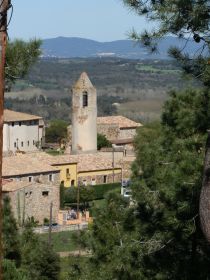 We follow the road around the bottom of the hill by fields full of crops bursting into growth in the warm spring sun - certainly warm enough that we don't need to wear jumpers or coats. The road itself is very quiet, really just connecting a few farms and the hamlet and is marked as part of a longer footpath from Sant Colomers de Farners to Angles. It's pleasant good walking countryside in among hills, but without being spectacular.
We follow the road around the bottom of the hill by fields full of crops bursting into growth in the warm spring sun - certainly warm enough that we don't need to wear jumpers or coats. The road itself is very quiet, really just connecting a few farms and the hamlet and is marked as part of a longer footpath from Sant Colomers de Farners to Angles. It's pleasant good walking countryside in among hills, but without being spectacular.
The marked footpath leaves the road and takes a track past two expansive masia and we could continue, but as we want to make a round trip, we take a left down the track back towards Brunyola's hill. At the end of the track we are back on the road, but this time we practically just cross over and go back into the woods across a small stream and follow the path as it snakes around the bottom of the hill. We're looking to climb the hill and for a while it looks as if there is no path up, but as we're approaching another farm by an olive grove, we see a switchback to our left that takes us up the hill.
As the path climbs, the views get better, but we're starting to feel the heat from the sun now so we're perspiring as we get towards the top. There's a viewpoint right at the peak, but we cut around the edge and follow the path along the top of the hill as it slowly descends to Brunyola. As we get back, the colonies house seems full of families after their lunch with children playing in the playground.
Nearby: Palafolls castle- Hostalric stroll - Lake at Sils - Castell de Montsoriu - Santa Coloma de Farners - Arbucies autumn walk - Caldes de Malavella - Volca de la Crosa - Sant Dalmai (Girona Airport) - Castell de Montsoriu
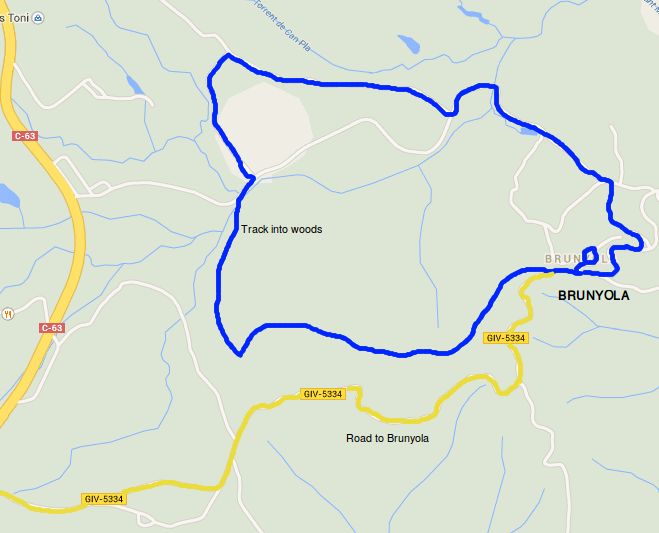
Cadaques and Port Lligat
 Cadaques is one of the most famous coastal villages in Catalonia and was where the surrealist painter Salvador Dali lived and worked in his coast-side house at Port Lligat. The town is on the Cap de Creus penisular and is really quite isolated separated by 12km of winding narrow roads over the hills from the neighbouring towns of Roses or to Port de la Selva. The remoteness, the narrow streets - some less than a metre and a half wide - and white washed buildings and arid hills behind makes Cadaques feel unique. In some ways it is almost more like a Greek Mediterranean village than Spain. It's this remoteness and uniqueness combined with the pure light of the coast that lures people to Cadaques
Cadaques is one of the most famous coastal villages in Catalonia and was where the surrealist painter Salvador Dali lived and worked in his coast-side house at Port Lligat. The town is on the Cap de Creus penisular and is really quite isolated separated by 12km of winding narrow roads over the hills from the neighbouring towns of Roses or to Port de la Selva. The remoteness, the narrow streets - some less than a metre and a half wide - and white washed buildings and arid hills behind makes Cadaques feel unique. In some ways it is almost more like a Greek Mediterranean village than Spain. It's this remoteness and uniqueness combined with the pure light of the coast that lures people to Cadaques
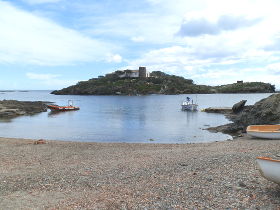 For us this is only our second visit so we're not aiming for a complex route - something simple and straightforward to get a feel for the area is perfectly fine for us, so this is just a standard easy-to-follow Cami de Ronda route.
For us this is only our second visit so we're not aiming for a complex route - something simple and straightforward to get a feel for the area is perfectly fine for us, so this is just a standard easy-to-follow Cami de Ronda route.
Arriving in Cadaques by car there are big signs about the general lack of car parking with the advice that cars should park in the main paying municipal car park which we did, but it's a little expensive - close to 3 euros an hour. If you are walking, we discovered there is free parking out towards Port Lligat and the cemetery which is far enough out of town to be a good 10 minute walk to the centre and would have space out of season.
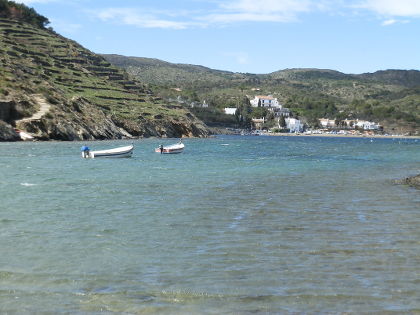 The old part of Cadaques sits on a small hill with the church at the top. The main car park sits just behind this hill, but lower down, so to start we head up the hill towards the church, through the very narrow streets lined with terraces of white-walled houses that give Cadaques its distinctive look. The streets themselves have a stoned surface, though unlike cobblestones these are narrower more slate-like stones with edges upwards in diagonal or herring-bone fashion and in places the road itself is actually the raw rock of the hill.
The old part of Cadaques sits on a small hill with the church at the top. The main car park sits just behind this hill, but lower down, so to start we head up the hill towards the church, through the very narrow streets lined with terraces of white-walled houses that give Cadaques its distinctive look. The streets themselves have a stoned surface, though unlike cobblestones these are narrower more slate-like stones with edges upwards in diagonal or herring-bone fashion and in places the road itself is actually the raw rock of the hill.
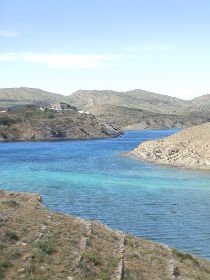 The church, being the high point of this part of the town, has views from its small courtyard in the front towards the sea and along to the cliffs and lighthouse in the distance on the right. Taking our fill, we head down towards the sea through the lanes passing by houses with plant pots outside their windows and pots lining the street edges.
The church, being the high point of this part of the town, has views from its small courtyard in the front towards the sea and along to the cliffs and lighthouse in the distance on the right. Taking our fill, we head down towards the sea through the lanes passing by houses with plant pots outside their windows and pots lining the street edges.
At the beach, the town suddenly seems busier. The beach at Cadaques is a rock and shingle beach - people generally wouldn't come here for a beach holiday - the town has much too much character for that, and the area is generally rocky and stony, with the sedimentary layers of the rocks occasionally turned vertical and eroded and sharp, but perfect for diving, fishing or water sports. The beach itself has plenty of people even for March, though wrapped in coats against the wind. Around the beach area are restaurants and bars and a central statue of Dali looking back towards the town.
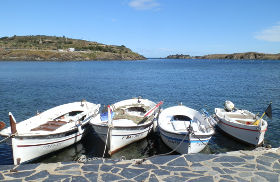 We continue across the beach and then around the Cami de Ronda. To begin with the path shares the road as it runs next door to the sea. We're on the leeside of the bay so the wind has dropped and each time we turn back we get another picture postcard view of Cadaques.
We continue across the beach and then around the Cami de Ronda. To begin with the path shares the road as it runs next door to the sea. We're on the leeside of the bay so the wind has dropped and each time we turn back we get another picture postcard view of Cadaques.
Towards the end of the bay we cross another small rough sand beach and take the path around the outside of a house as it runs around the top of the final set of rocks that have views back to town. Across the bay we can see the cliffs and an isolated lighthouse. There is more walking in this area including routes to Roses about 16km away - too far for a family round trip.
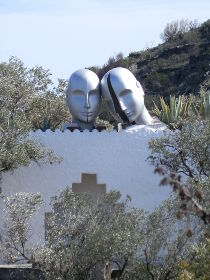 Around the house and the headland, Cadaques disappears and the scenery changes - becoming bleaker with much more rock stringing out into the sea. Across from us is a small island with a house and a watch tower on it. From behind it looked like another headland, but we can see now there is open water between the beach in front of us and the island.
Around the house and the headland, Cadaques disappears and the scenery changes - becoming bleaker with much more rock stringing out into the sea. Across from us is a small island with a house and a watch tower on it. From behind it looked like another headland, but we can see now there is open water between the beach in front of us and the island.
The path continues around any number of rock headlands - perfect for hunting crabs in the summer or for skimming stones from the beaches. The sea in the distance from us is stormy with white horses, but close to the bay the water is smoother. Just inland from the sea front are newer houses and modern architecture villas that seem a little out of place from the wildness of the coast.
At the end of the headland we cross a rise and get the full blast of the wind in our faces. The sea below us is much more open to the elements with waves crashing against the rocks, but with a deep blue sea that we can see all the way to France.
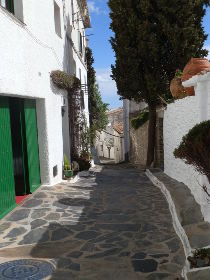 We follow the road down past a row of seaside houses that seem to be snuggling next to each other to keep out the wind. The headland is more like a spit so we have to turn around. Fortunately we see the Cami de Ronda sign which takes us down a narrow track into the woods and a scramble down to the bay between the spit and the main land. In front of us we can see a wild, almost Scottish landscape with the huddle of houses of Port Lligat in the distance, but no other buildings nearby.
We follow the road down past a row of seaside houses that seem to be snuggling next to each other to keep out the wind. The headland is more like a spit so we have to turn around. Fortunately we see the Cami de Ronda sign which takes us down a narrow track into the woods and a scramble down to the bay between the spit and the main land. In front of us we can see a wild, almost Scottish landscape with the huddle of houses of Port Lligat in the distance, but no other buildings nearby.
We cross the beach in the bay and follow the track along the side of this new bay. Above us are ancient looking terracing for olive or vine cultivation that look as if they could have been on the hill since Roman times. The path is still narrow and 2-3 metres above the sea. At one point we have to cross sloping rocks that seem to want us to make us slide into the sea.
And then we arrive in Port Lligat, a handful of brightly coloured fishing boats on the small quayside and then around the corner at we're at Dali's house. We're not visiting the museum and from the port side it looks like a large traditional Catalan house, but with white walls with a few neighbouring houses. We take the chance to enjoy the view and the location then take the road up the hill. As we go up we can see the Daliesque touches like ceramic eggs on the roof and two silver heads, but it is much more subtle touches than Figueres for instance.
Then back into town, cutting into the confusing network of small lanes to see if we can navigate our way back. We arrive at the main square with trees wearing knitted sleeves and navigate through more streets and back to the car.
Neighbouring walks: Cadaques to Roses - Roses and Roses Ciutadella - Roses - Canyelles beaches to Cap Falconera - Port de la Selva - Sant Pere de Rodes - Llança - Collioure (France)
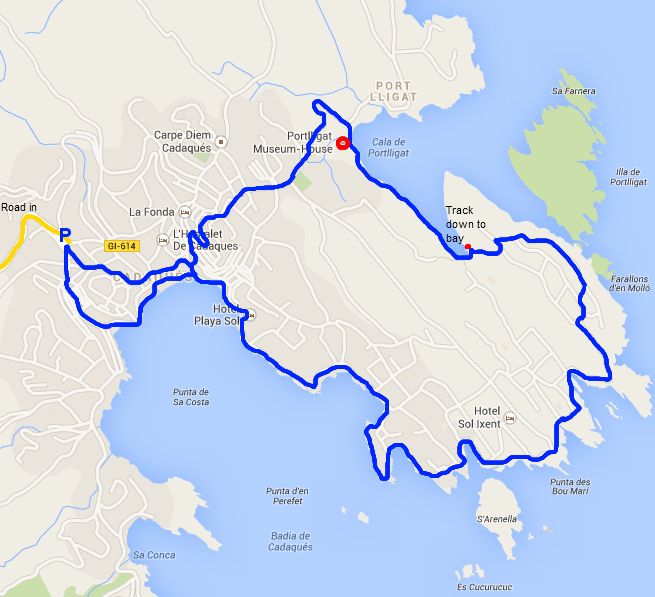
And now an earthquake...
Having just had a large forest fire on the Costa Brava, now we've just had a small (3.9 Richter Scale) earthquake with an epicentre just off the coast between Palamos and Palafrugell. It's quite unusual - the Costa Brava is definitely not an earthquake zone - and the size was nowhere near large enough to cause any damage, but enough to shake the house a little and raise a few eyebrows. We have building work next door and had assumed it was connected to the builders digging out foundations creating some ground movement until we saw the news that confirmed it was a genuine seismic event.
Fire on the Costa Brava
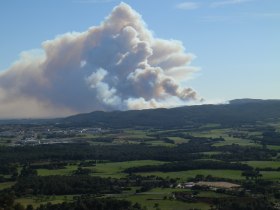 A big plume of smoke rising out of the Gavarres at about 2.30pm yesterday put our walking plans on hold as a huge forest fire had started in Vall.llobrega which is about 2-3km from us. Forest fires are relatively common around the Emporda area but still quite devastating when they happen and one reason for being very careful not to start fires in the woods. For March to October, fires are banned from wooded areas or their vicinity because of the risk of a large scale incident and ironically yesterday was the second day of this year's no-fire season.
A big plume of smoke rising out of the Gavarres at about 2.30pm yesterday put our walking plans on hold as a huge forest fire had started in Vall.llobrega which is about 2-3km from us. Forest fires are relatively common around the Emporda area but still quite devastating when they happen and one reason for being very careful not to start fires in the woods. For March to October, fires are banned from wooded areas or their vicinity because of the risk of a large scale incident and ironically yesterday was the second day of this year's no-fire season.
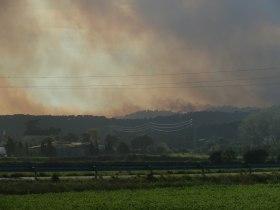 The second major factor in the bigger fires is the northerly Tramuntana. wind. This is usually a very strong and very dry wind that blows from the north and yesterday's coincided with a very dry hot day with temperatures reaching 27C in March. The wind whips across the woods and helps the flames to spread. Thankfully we were just to the north of the starting point for the fire, so the smoke and flames were heading away from us an area that we frequently use for walking and exploring.
The second major factor in the bigger fires is the northerly Tramuntana. wind. This is usually a very strong and very dry wind that blows from the north and yesterday's coincided with a very dry hot day with temperatures reaching 27C in March. The wind whips across the woods and helps the flames to spread. Thankfully we were just to the north of the starting point for the fire, so the smoke and flames were heading away from us an area that we frequently use for walking and exploring.
We did sneak a trip down towards Palamos and could see both the smoke and flames in the trees just above Vall.llobrega which, from where we were sitting, looked dramatically close. However, though around 400 people were evacuated, reports suggest the fire didn't reach houses. The fire though subsided in the evening, though there are still fire crews around and reports that it is not yet completely extinguished.
We postponed our planned walk and instead went to Quermany - the hill behind Regencos on what was a fabulously clear day (the views from Quermany across Pals and Peratallada to Canigou in the Pyrenees are spectacular) and watched the fire and helicopters and planes from the safe distance.
Gavarres Montnegre and Montigalar
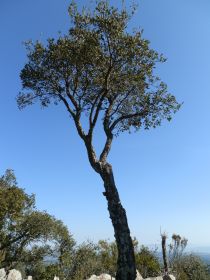 Montnegre (black mountain) is a name that is found several times in Catalonia but for today refers to an area in the heart of the Gavarres above the town of Quart and not too distant from Girona. It's possible to cross the Gavarres north to south by one of four roads - over Els Angels from Girona to Madremanya, over the centre from Cassa de la Selva to La Bisbal, across from Calonge to La Bisbal, and the area we're exploring today which is the route from Quart to Monells - though this is only tarmac for the Quart side of the mountain.
Montnegre (black mountain) is a name that is found several times in Catalonia but for today refers to an area in the heart of the Gavarres above the town of Quart and not too distant from Girona. It's possible to cross the Gavarres north to south by one of four roads - over Els Angels from Girona to Madremanya, over the centre from Cassa de la Selva to La Bisbal, across from Calonge to La Bisbal, and the area we're exploring today which is the route from Quart to Monells - though this is only tarmac for the Quart side of the mountain.
The central part of the Gavarres is quite large, mostly wooded, but with masias, churches, the occasional modern villas and surprising hidden fields from time to time. We're visiting an area we haven't really explored before so rather than start at the base, we decided to bring the car up as it would add about 16km up and down to the walk if we were to start from Quart. The roads up and across the Gavarres though are famed as cycling training routes for professional cyclists, and it is possible to cycle up - the gradients aren't too bad, it's just the 8-10km of climb that makes it a challenge.
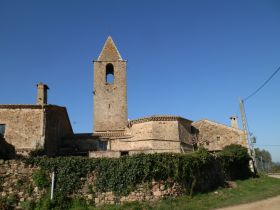 We decided to start at the church of Sant Matteu de Montnegre. This is a small church perched on a promentary with huge views across the Gavarres to the Empordan plain to the north and the Girona plane to the south. There are routes down into the valley to the left and right and but our goal though is to find the hamlet of Montnegre on the neighbouring promentary, and unfortunately that means following the tarmac road that links the two. There should be crossings through the valley, but even with a map there are no clear paths for crossing the valley.
We decided to start at the church of Sant Matteu de Montnegre. This is a small church perched on a promentary with huge views across the Gavarres to the Empordan plain to the north and the Girona plane to the south. There are routes down into the valley to the left and right and but our goal though is to find the hamlet of Montnegre on the neighbouring promentary, and unfortunately that means following the tarmac road that links the two. There should be crossings through the valley, but even with a map there are no clear paths for crossing the valley.
From Sant Matteu we pass a number of houses - despite the relatively remoteness there are scattered modern houses in a sort of extended urbanisation with more infrequent older farmhouses around. The road is modern and done up and curls around the ridgeway that connects the two promentaries.
It's March, but warm and there are lots of hunters out who have driven up with dogs. It's always slighly unnerving to see someone cradling a rifle as you walk past and as we're dressed in green jackets (the hunters wear orange) it's slightly worrying for when we come off the path into the woods just in case they don't see us. The object of the hunters quest are wild boar - senglars in Catalan. The Gavarres teem with them and anywhere you walk you'll see signs of disturbed earth where the boar root around for food. To hunt, dogs are used to locate the boar - dogs with bells or wireless transmitters are let loose in the undergrowth to sniff out the animals - the bells acting so the hunters and locate the dogs later. When the dogs find the boar, they start barking so the hunters know where to go.
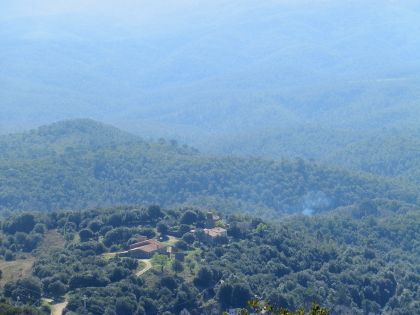 We leave the road and head for the viewpoint at the top of Montigalar. The path cuts into the woods and from the voices and ringing bells we can hear, but not see, the hunters in the woods to the left and right. We can also see the hunters cars some of which must have driven up the narrowest paths to find somewhere to park.
We leave the road and head for the viewpoint at the top of Montigalar. The path cuts into the woods and from the voices and ringing bells we can hear, but not see, the hunters in the woods to the left and right. We can also see the hunters cars some of which must have driven up the narrowest paths to find somewhere to park.
Our route though takes us up the hill until we reach the top which is marked by a triangulation point and the Estrellada Catalan Flag. At the bottom of the flagpole is a small pessebre nativity scene to mark the spot. The views are glorious out across Monells and La Bisbal, or across the folds of the Gaverres in the other direction.
We take a moment to wait until the encroaching hunting noises including the sounds of several shots echoing through the hills, start to recede and continue down around the bottom of the hill beneath the viewpoint. At the bottom it joins with the path that we had taken from Monells up and then links to the tarmac road. We could turn right strat back to Sant Matteu, but since our objective was Montnegre we go left for the few hundred metres it takes to reach the small hamlet of houses. There's a small church/chapel here and we walk down the lane to find it, but it's not clear if there is public access.
Instead, we turn round and follow the road back, seeing a couple of road cyclists making their first ascent of the day. The sun is out. It's warm and we have the first butterflies in among the wild hyacinths so it's a shame we have to walk the same road back as we'd taken out.
Gavarres walks: Girona and Castell de St Miquel - Calonge into the Gavarres - St Pol de Bisbal and Santa Lucia - Monells and Mont-negre - Celra, Juia and the Castle of Palagret - Madremanya, Els Angels, Sant Marti Vell - Romanya de la Selva to Puig d'Arques
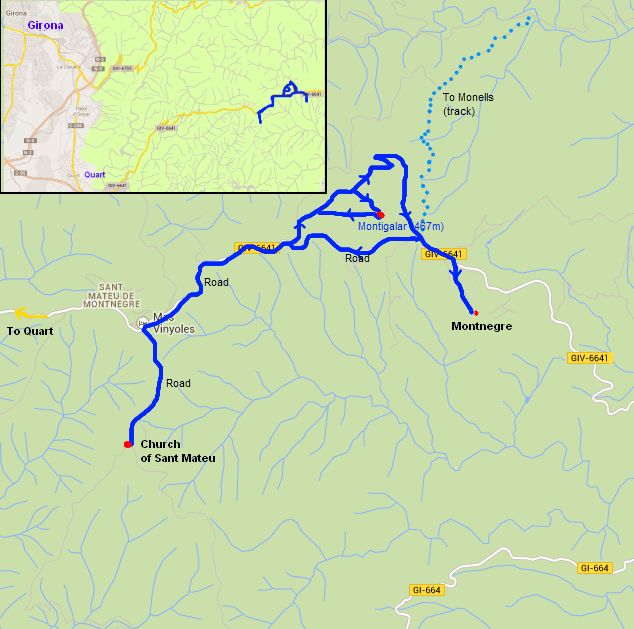
Sant Jordi Desvalls, Colomers and Sant Llorenç de les Arenes
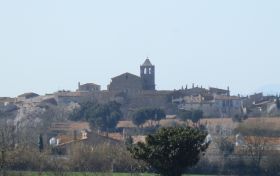 The river Ter is the main river that runs from Pyrenees through Girona to the coast of the Costa Brava by L'Escala and Torroella de Montgri where it feeds the rice paddies around Pals. The Ter has water all year round and is broad by the time it gets past Girona making a natural barrier that has to be crossed to get from the southern towns like Palafrugell to the more northern towns like L'Escala and there only a limited number of crossing points, with bridges at Verges, Torroella de Montgri and Girona.
The river Ter is the main river that runs from Pyrenees through Girona to the coast of the Costa Brava by L'Escala and Torroella de Montgri where it feeds the rice paddies around Pals. The Ter has water all year round and is broad by the time it gets past Girona making a natural barrier that has to be crossed to get from the southern towns like Palafrugell to the more northern towns like L'Escala and there only a limited number of crossing points, with bridges at Verges, Torroella de Montgri and Girona.
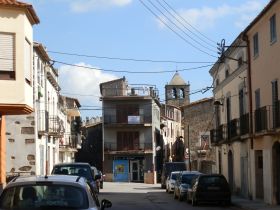 However, there is a hidden extra crossing close to Flaça and this is actually a raised ford rather than a bridge. When the river is low, the water runs under the ford, but if it gets higher water will run over the top. From our walk near Colomers we also discovered from signposts that there is another crossing for bikes and by foot close to Colomers. This walk then creates a loop linking the two crossings and the neighbouring villages, starting on the hill of Sant Jordi Desvalles.
However, there is a hidden extra crossing close to Flaça and this is actually a raised ford rather than a bridge. When the river is low, the water runs under the ford, but if it gets higher water will run over the top. From our walk near Colomers we also discovered from signposts that there is another crossing for bikes and by foot close to Colomers. This walk then creates a loop linking the two crossings and the neighbouring villages, starting on the hill of Sant Jordi Desvalles.
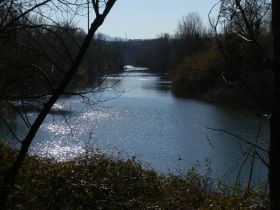 We parked on the outskirts of Sant Jordi Desvalles which stands above the Ter and looks over the levels of Flaça across to the Gavarres. The village has a medieval heart arranged n circle of terraced streets for defensive reasons, and many of the old buildings in the centre are built on a large jutting base that would have added strength and fortification. Many of the houses have been renovated and from the Plaça underneath the church, the village has the feeling of a relatively well-to-do village with good access to Girona.
We parked on the outskirts of Sant Jordi Desvalles which stands above the Ter and looks over the levels of Flaça across to the Gavarres. The village has a medieval heart arranged n circle of terraced streets for defensive reasons, and many of the old buildings in the centre are built on a large jutting base that would have added strength and fortification. Many of the houses have been renovated and from the Plaça underneath the church, the village has the feeling of a relatively well-to-do village with good access to Girona.
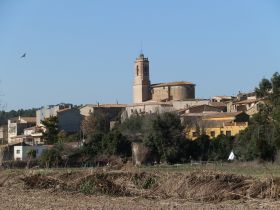 Our route though is taking us out into the fields along Carrer Mas Mato. We're on a road but it's almost unused as it just connected to a neighbouring cluster of farm houses at Mas Mato. On the other side, we pass under the railway - this is the route from Girona to Port Bou - the main connection to France until the recent AVE road was built through the Pyrenees. As such it's quite busy with trains with both passengers and freight.
Our route though is taking us out into the fields along Carrer Mas Mato. We're on a road but it's almost unused as it just connected to a neighbouring cluster of farm houses at Mas Mato. On the other side, we pass under the railway - this is the route from Girona to Port Bou - the main connection to France until the recent AVE road was built through the Pyrenees. As such it's quite busy with trains with both passengers and freight.
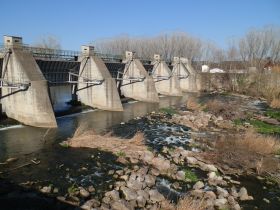 On the other side of the bridge we head towards the fields that fringe the river. We can't see the water as the path is too far away from the edge, but we can see the line of trees that flank it's banks. The road we're on comes to an end with a T-junction with signposting pointing right towards Flaça. We take the unmarked left route though in the other direction towards Colomers.
On the other side of the bridge we head towards the fields that fringe the river. We can't see the water as the path is too far away from the edge, but we can see the line of trees that flank it's banks. The road we're on comes to an end with a T-junction with signposting pointing right towards Flaça. We take the unmarked left route though in the other direction towards Colomers.
 As we get closer to Colomers, we also get closer to the GI-633 road. The road is sort of a rat-run connecting the AP7 and N2 to the north of Girona through Colomers, Jafre and on to Torroella avoiding the busier C66 on the south side of the Ter - it's not that busy, but it is popular with people driving quickly.
As we get closer to Colomers, we also get closer to the GI-633 road. The road is sort of a rat-run connecting the AP7 and N2 to the north of Girona through Colomers, Jafre and on to Torroella avoiding the busier C66 on the south side of the Ter - it's not that busy, but it is popular with people driving quickly.
So because of the geography, just outside the village, as we get our first close glimpse of the river as it follows a big right hand bend, this also makes a pinch point where the road and the river run side by side and, unfortunately, there is no easy footpath to avoid the road so we have to follow the road and walk behind the crash barriers.
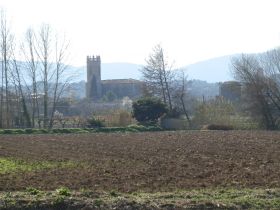 Around the corner, the walking is easier again and we can walk past the Colomers Kayak and Canoeing centre where you can rent boats and canoe down the Ter as far as Verges. We've walked this little bit before (Colomers and Jafre walk) but in reverse, so we know we have to stay by the road to start then take a right into the fields again following the bike path towards Foixa. It was seeing the signpost previously that made us realise that there's a crossing point for the river here.
Around the corner, the walking is easier again and we can walk past the Colomers Kayak and Canoeing centre where you can rent boats and canoe down the Ter as far as Verges. We've walked this little bit before (Colomers and Jafre walk) but in reverse, so we know we have to stay by the road to start then take a right into the fields again following the bike path towards Foixa. It was seeing the signpost previously that made us realise that there's a crossing point for the river here.
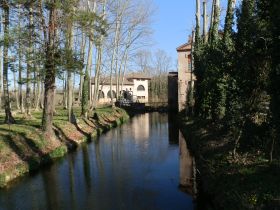 We follow the road down towards the river and then round behind an old water works and we reach a large mechanical flood barrier that spans the river. From our walks around the upper part of the river at Roda de Ter, we know that the Ter can flood as it brings water and rain down from the Pyrenees to the sea. The barrier here is presumably to protect the downstream towns of Torroella.
We follow the road down towards the river and then round behind an old water works and we reach a large mechanical flood barrier that spans the river. From our walks around the upper part of the river at Roda de Ter, we know that the Ter can flood as it brings water and rain down from the Pyrenees to the sea. The barrier here is presumably to protect the downstream towns of Torroella.
We cross the barrier - it's fully open and the river looks very benign as it runs over the wier and rocks. On the other side it's just woods and the occasional field with no sign of habitation. We're on a track through the woods and have to be careful to take the first right we come to up a small hill and then another right on the other side which brings us out to the first houses of Sant Llorenç de les Arenes - a hamlet of older houses with gardens that feels quite isolated. We can also see the river now beneath us on the left. The path is road once more and we continue through the heart of the hamlet and then out the other side past more renovated farmhouses situated above the river and we could almost be walking along the Dordogne with the French sense of a route along a gentle river valley.
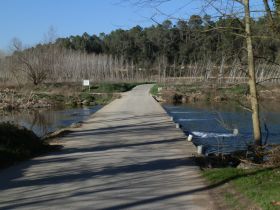 The road turns away from the river for a while and we pass under another railway bridge and on past an old factory mill house with a castle-like tower and palm trees in the garden. We reach the road that takes us down to the ford at Sobranigues that connects Flaça to the other side of the Ter. It's popular with locals as a connection so there are a few cars that pass us on the road. At the junction we can see the old church and village at Flaça in the distance. Many visitors only see the new area around Flaça station, so don't realise that the town also has a well-preserved and slightly separate older part.
The road turns away from the river for a while and we pass under another railway bridge and on past an old factory mill house with a castle-like tower and palm trees in the garden. We reach the road that takes us down to the ford at Sobranigues that connects Flaça to the other side of the Ter. It's popular with locals as a connection so there are a few cars that pass us on the road. At the junction we can see the old church and village at Flaça in the distance. Many visitors only see the new area around Flaça station, so don't realise that the town also has a well-preserved and slightly separate older part.
The ford itself takes the form of a low bridge with water passing underneath. The first time we found this route there was more water and we had to drive through the river as a proper ford. We find it at lower water, with the river passing underneath the ford into a broad pool under the rocks as it curves to the left beneath the village. It's a very pleasant place to stop and there are places to explore the shore line and river beaches along the river nearby.
After taking a break we follow the road up to the houses of Sobranigues and then take a track to the left that curls around the hill, past a couple of farms, and we find ourselves back in Sant Jordi Desvalls.
Neighbouring walks: Colomers and Jafre - Rupia and Foixa - Madremanya, Els Angels, Sant Marti Vell - Bordils and the tree plantations of the Ter - Celra, Juia and the Castle of Palagret - Cervia de Ter - Roman fort at St Julia de Ramis (Girona)

Bordils and the tree plantations of the Ter
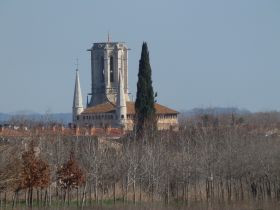 Bordils is one of the towns on the northern C66 route from Girona to the Costa Brava via La Bisbal that tracks the river Ter. From the main road the impression of Bordils is of a string of buildings along the main road, when in actual fact the town, like many of the towns on this route, sits a little way off. In Bordils case this is about 1km into the plain marked by a very large impressive church.
Bordils is one of the towns on the northern C66 route from Girona to the Costa Brava via La Bisbal that tracks the river Ter. From the main road the impression of Bordils is of a string of buildings along the main road, when in actual fact the town, like many of the towns on this route, sits a little way off. In Bordils case this is about 1km into the plain marked by a very large impressive church.
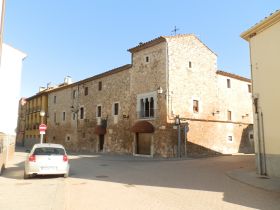 We're actually back in Bordils to watch a handball match so this is a short exploration of the town and the area around, but because of the match we start at the sports stadium and then follow the road in towards the main church. Most of this area is an estate of large modern homes and it's not until we get closer to the centre that we get to see older buildings and a more classic nucleus.
We're actually back in Bordils to watch a handball match so this is a short exploration of the town and the area around, but because of the match we start at the sports stadium and then follow the road in towards the main church. Most of this area is an estate of large modern homes and it's not until we get closer to the centre that we get to see older buildings and a more classic nucleus.
From the size of the church and the style of the buildings the town itself looks as if it was a wealthy farming community. The church is tall with a apse flanked by two pointed towers, but the heart of the village is relatively small apart from a number of larger masias.
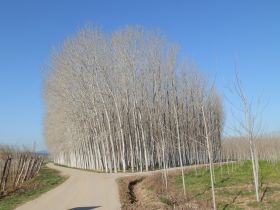 After circumscribing the town centre we head out into the farm land and trees. Mostly the trees are fruit trees growing in the fertile soil and ample water from the river Ter, with large birch or beech plantations. The morning is fresh but in bright sun so even though the trees are without leaves the light adds sharpness and depth.
After circumscribing the town centre we head out into the farm land and trees. Mostly the trees are fruit trees growing in the fertile soil and ample water from the river Ter, with large birch or beech plantations. The morning is fresh but in bright sun so even though the trees are without leaves the light adds sharpness and depth.
The road is empty apart from a cyclist and there is nothing around apart from the trees and two or three very large masias, and it's not just fruit trees - there are also specialist plantations of palms and decorative trees for garden centres. The road turns naturally to the left and we pass between two old masias and then start to approach the main road and industrial area. One of the masias was an old mill and still has water passing underneath, though it's now waiting for renovation.
We follow the mill stream back through the large warehouses of Girona Fruit and back across the fields to the sport centre.
See also: Girona and Castell de St Miquel - Roman fort at St Julia de Ramis (Girona) - Madremanya, Els Angels, Sant Marti Vell - Celra, Juia and the Castle of Palagret - La Pera, Pubol and around - Sant Jordi Desvalls, Colomers and Sant Llorenç de les Arenes
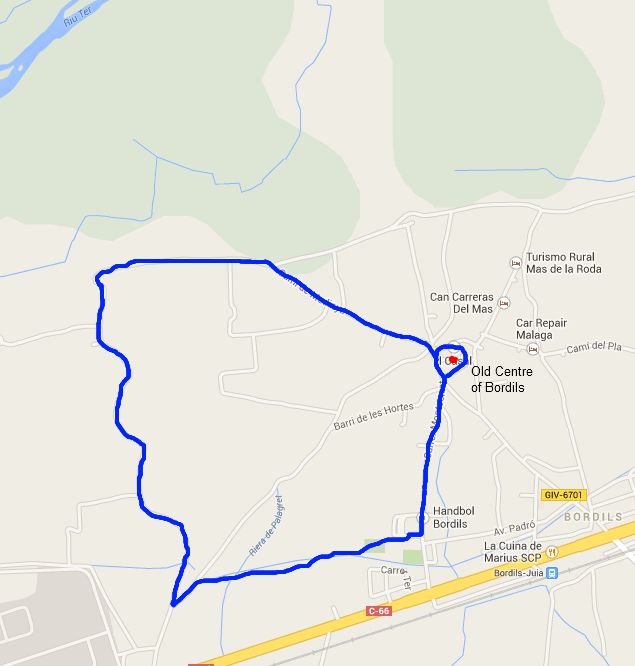
Llagostera to Sant Llorenç
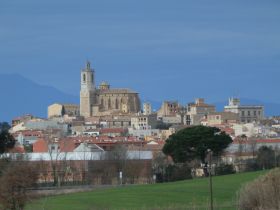 Llagostera literally stands above the roads that connect Girona and Barcelona to the Costa Brava and as such is one of the markers that the coast is not far away. Because of it's position at the head of the Aro valley, it is a town with a lot of history and interest, even though many people will just go straight past on the way to the coast, or back to the airport.
Llagostera literally stands above the roads that connect Girona and Barcelona to the Costa Brava and as such is one of the markers that the coast is not far away. Because of it's position at the head of the Aro valley, it is a town with a lot of history and interest, even though many people will just go straight past on the way to the coast, or back to the airport.
 We park on the Caldes de Malavella side at the bottom of the hill that leads to the castle. From this side, a steep road runs up to the top just outside the castle walls. The area has been restored and there are rings of streets that would have been part of the town walls. We're exploring at this point so our route is haphazard up and round in rings until we eventually take the stairs from a lower square up to the main castle and church level. Unusually there's a little bit of rain - normally even in winter we walk in dry conditions as it's unusual to have more than two or three days rain on the trot.
We park on the Caldes de Malavella side at the bottom of the hill that leads to the castle. From this side, a steep road runs up to the top just outside the castle walls. The area has been restored and there are rings of streets that would have been part of the town walls. We're exploring at this point so our route is haphazard up and round in rings until we eventually take the stairs from a lower square up to the main castle and church level. Unusually there's a little bit of rain - normally even in winter we walk in dry conditions as it's unusual to have more than two or three days rain on the trot.
The church is large and imposing with a Baroque facade standing in a large plaça that would have been the main courtyard for the castle with towers looking out from the hill top. The views are extensive along the dead straight road to Cassa de la Selva and on to Girona, or across to the hills of Gavarres and L'Ardenya. Our route down is also haphazard, turning when we see something that looks interesting, like a water fountain with a big handwheel to pump the water.
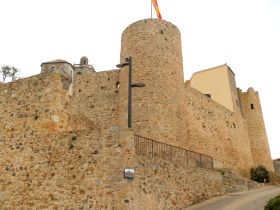 The town itself is quite large and well kept with many interesting buildings and practically a commuter town for Girona. The last time we were in Llagostera, there were people in home-made carts and buggies rolling down the hill from the castle in the annual cart-race which sees people dress up and make creatively decorated unpowered vehicles run down the streets. This time Llagostera is quiet and we only really see people as we walk past the old Casino social club - a 1920s building by the side of a large modern square.
The town itself is quite large and well kept with many interesting buildings and practically a commuter town for Girona. The last time we were in Llagostera, there were people in home-made carts and buggies rolling down the hill from the castle in the annual cart-race which sees people dress up and make creatively decorated unpowered vehicles run down the streets. This time Llagostera is quiet and we only really see people as we walk past the old Casino social club - a 1920s building by the side of a large modern square.
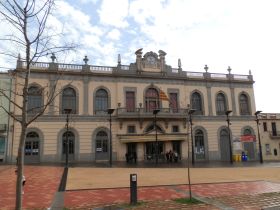 Heading out, we find the town rambla and then reach the outskirts and the route for the Carrilet - the viaverde bike route that connects Girona to Sant Feliu. We follow it north a little way to find our path out via the Mas Gottara estate and into the fields and farms. The road we're on turns to a dirt track and we head out towards the C35, stopping to admire the view from the low hill.
Heading out, we find the town rambla and then reach the outskirts and the route for the Carrilet - the viaverde bike route that connects Girona to Sant Feliu. We follow it north a little way to find our path out via the Mas Gottara estate and into the fields and farms. The road we're on turns to a dirt track and we head out towards the C35, stopping to admire the view from the low hill.
Our path though, runs through a tunnel under the road and out towards an old Indiana-style estate house on the other side. The tunnel has a surprisingly long echo which entertains the children.
We did want to get to see the state of the Indiana house - from the C35 dual carriageway (it's the arm that goes towards Barcelona) we pass this way and the house looks intriguing. Unfortunately the only way to approach it from our path is on a private road and we're discouraged from visiting by a neighbour in his garden.
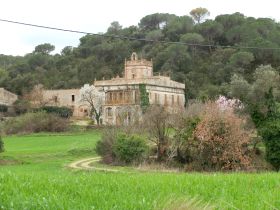 Instead, we continue on through the woods and past another enormous masia before reaching the road at the bottom. There's a little bit of a zig-zag here, we have to turn left, then right along the road looking for our next target - the chapel of Sant Llorenç. We pass a farm with sheep in the field - this is rolling farm country with a few wooded valleys in the distance. The chapel is on the small hill to our right and we find a small track that takes us up to the top. The chapel is more like an old stone barn with a bell on top so not so ancient but not particularly architecturally interesting.
Instead, we continue on through the woods and past another enormous masia before reaching the road at the bottom. There's a little bit of a zig-zag here, we have to turn left, then right along the road looking for our next target - the chapel of Sant Llorenç. We pass a farm with sheep in the field - this is rolling farm country with a few wooded valleys in the distance. The chapel is on the small hill to our right and we find a small track that takes us up to the top. The chapel is more like an old stone barn with a bell on top so not so ancient but not particularly architecturally interesting.
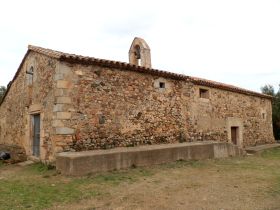 We take the track that runs down the hill from the chapel and then across the road to find our first signpost and we start to head back towards Llagostera. The rain has stopped and the day is brighter, but we follow a muddy track along the side of some woods with an enormous renovated masia complete with covered swimming pool to our right. We emerge back in the fields, but rather than continue towards Llagostera we go up the hill following the Carril Groc to see more views across Llagostera. Unfortunately the day is cloudy, but on a clear day we would be able to see the Pyrenees.
We take the track that runs down the hill from the chapel and then across the road to find our first signpost and we start to head back towards Llagostera. The rain has stopped and the day is brighter, but we follow a muddy track along the side of some woods with an enormous renovated masia complete with covered swimming pool to our right. We emerge back in the fields, but rather than continue towards Llagostera we go up the hill following the Carril Groc to see more views across Llagostera. Unfortunately the day is cloudy, but on a clear day we would be able to see the Pyrenees.
We then continue across the top of the hill, taking a left past a masia with a collapsable wind-turbine before rolling back down the hill to the road and a bridge back to Llagostera close to the access route to Mas Roure - a large restaurant that stands by the side of the dual carriageway.
Still dodging the main town, we take the track up to the picnic area and then around the back of Llagostera to the main through road and back past the castle to the car.
See also: Caldes de Malavella - Romanya de la Selva - Gavarres Montnegre and Montigalar - Tossa de Mar north to Cala Pola - Tossa de Mar to Cala Llorell - Sant Grau and Cadiretes near Tossa de Mar - Ruta del Carrilet - Girona cyclepath to the coast
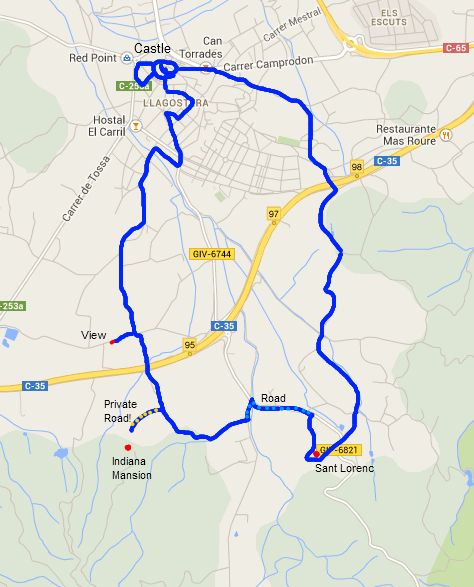
Sant Feliu de Guixols Pedralta
The hills to the back of Sant Feliu de Guixols are an area we don't know very well. Unlike the Gavarres they are somewhat more arid and rocky and feel more barren. This was a walk we took because it looked interesting on the map as it takes in two bits of the GR92 and a viewpoint. Unfortunately it was also a day that I forgot to take my camera...
This part of the GR92 links Tossa de Mar and Sant Feliu on the one hand, and has a branch of the GR92 that runs up to Romanya de la Selva. The actual connection between Tossa de Mar and Sant Feliu doesn't run close to the coast - though there is an extremely bendy coast road between the two towns.
Our starting point is in the Urbanisation of Pedralta which are a collection of villas spaced out among the hills just off the road which runs up from an industrial state just outside Sant Feliu. It would be possible to start at Sant Feliu, but instead we're about three-quarters of the way up, and we park in a small no-through road (Carrer Roure) just below the point at which the road and path up the hill separate. This is a very quiet area so there would be no problem taking the road up, but we follow the path which runs parallel to the road as we climb up the hill.
The hills around Sant Feliu are more arid and rockier than the Gavarres where we normally walk. The ground underfoot is much sandier and the alzinas more spread-out and despite rain recently, the ground is fast draining and quite dry. As we walk there are views out across to the sea at Sant Feliu and then the coast along Platja d'Aro and up even towards Begur. The path curls away from the road for a while and we can see across the valley of the river Aro across to Sant Cristina d'Aro.
Eventually the path we're on meets back up with the road. We turn right and follow the road way for a few hundred metres until we reach a broad clearing with signposts. There would be parking here and the road up is in good condition having been resurfaced recently, so it would be easy to drive up.
Taking a route through the clearing we pass, firstly a small chapel and secondly a large boulder which looks unsteady balancing on an outcrop to which a cross has been added. There's also a large pylon and then continuing to follow the path, we reach a viewing area with metal railings that is Puig Mirador. The view is spectacular, with a deep drop separating the viewing area from the hill just across. Behind us the hills are threadbare with expanses of yellow-orange rocks and promentories that limit the number of trees. To the left up the valley we can look towards the hills and mountains of Montseny and across the valley are the tops of the Gavarres. To the right, the sea view and the high-rises of Platja d'Aro.
We double back and head straight on across the GR92 up a small incline, and then follow a line of pylons. On this side of the hill, it is almost all rough hills and trees with no habitation visible and just a few tracks running into the hills. According to the map we are running parallel to a lower stretch of the GR92 as it comes up from Tossa de Mar, so we're hoping for an unmarked route or scramble that we can taken down in order to be able create a loop for the walk. It takes a while but we find a path to the left. It's a little steep but one that other people have used so steady going.
At the bottom we're back on the GR92 again. The path though is still a small track and it wends it's way around the side of the hill. We just have to follow the path, and except for one moment under a pylon where someone has scrawled Pedralta on the base suggesting a second path, we follow the track down to a split point (Tres Camins).
Instead of taking the Sant Feliu branch we take the Romanya direction behind one of the villas and around the top of a sparsely built estate to get back to the road up to Pedralta, and as it's very quiet we head down the road and back to the car.
See also: Solius, rocks for climbing and ruined castle - Tossa de Mar north to Cala Pola - Tossa de Mar to Cala Llorell - Sant Grau and Cadiretes near Tossa de Mar - Platja Sant Pol to Sant Feliu de Guixols - Via Ferrata at the Gorges de Salenys
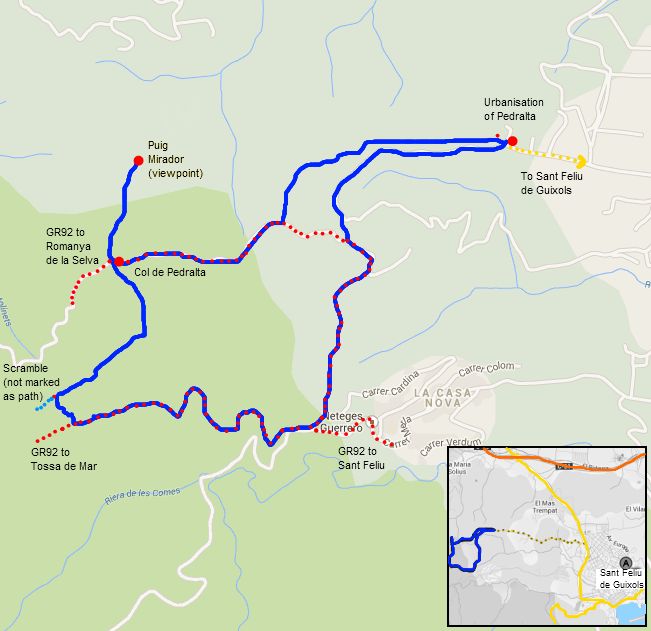
Castello d'Empuries
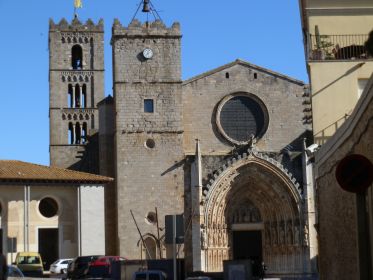 Castello d'Empuries was, until the middle of the 14th Century, the capital of the county of Empuries which encompassed almost the whole of the Emporda region and was a rival to the counts of Barcelona.
Castello d'Empuries was, until the middle of the 14th Century, the capital of the county of Empuries which encompassed almost the whole of the Emporda region and was a rival to the counts of Barcelona.
Castello d'Empuries itself sits slightly inland on the Muga river as, in the Middle Ages, this was an area of lakes and sea-marshes (aiguamolls) that were progressively drained or silted up. In recent times, these areas have been converted into the wetland bird sanctuaries of the Aiguamolls d'Emporda and d'Alt Emporda for the visiting flamingos, storks and other migrating and native birds.
However, an area of the wetlands was drained in the 1960s and converted into one of Europe's largest residential marinas - Empuriabrava - a network of linked canals with houses, where each house has it's own mooring space.
For tourists, it's easy to see the somewhat overblown Empuriabrava and miss the much more interesting and historic neighbouring town of Castello d'Empuries behind it.
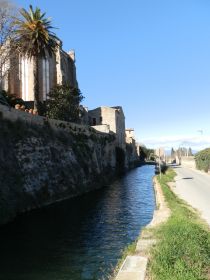 We want to visit for the history as much as anything.
We want to visit for the history as much as anything.
Castello d'Empuries is the only town in the Emporda region with a Cathedral (actually a Basilica) illustrating it's former importance.
For walking, because of the previous lake, much of the surrounding area forms a flat plain crossed by ditches and drains that mean relatively few circular paths. As a result we're playing it by ear to see what we find, rather than having too strong a plan of places to go - we just know we're not heading for Empuriabrava today.
We park at the sports centre. In Catalonia, practically every town with more than 2,000 inhabitants has some form of Poliesportiu Municipal mostly used by one or two particular sports clubs, like handball, basketball, football sala, but also more exotic sports like roller hockey or roller dance - so mostly organised sports and often much more a simple community facility than the professional 'leisure centre' in the UK.
From the sports centre we walk into the centre of town in through older traditional stone terraced houses.
Being a Sunday everything is closed, but walking through the streets, Castello d'Empuries shows it's medieval heritage with large buildings and ornate stone window dressings.
In the early part of September each year, Castello has a Festival of Troubadors - medieval singers - with the whole town reliving it's past with events like jousting.
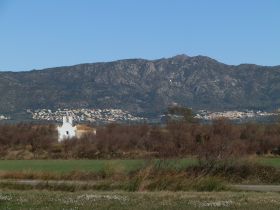 After zig-zagging through the streets we get to the Basilica de Sant Maria - known as the Cathedral of Empuries.
After zig-zagging through the streets we get to the Basilica de Sant Maria - known as the Cathedral of Empuries.
When Catalunya first emerged as a buffer state between the Franks and the Moors in the 9th century, it consisted of a set of semi-independent counties - literally areas ruled by a count.
As time passed and the counties became more established, rivalries grew up between the different counts resulting in a series of skirmishes/battles between the Counts of Empuries based in Castello and the Counts of Barcelona who were the dominate ruling family in Catalonia at the time.
Eventually the rivalries were settled by intermarriage between the leading families (these unions by marriage eventually leading all the way to the unified Spanish monarchy of Ferdinard and Isabella) which then saw Castello diminished in influence as Barcelona became the pre-eminent centre of Catalonia.
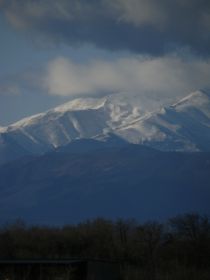 We take the road to the right of the Cathedral and emerge outside the old walls of the town by a river/moat.
We take the road to the right of the Cathedral and emerge outside the old walls of the town by a river/moat.
Historically, the area we can see from this point between Castello and Roses was a lake until about the 16th century providing both fishing and protection for the town.
Gradually, as with many of the shallow lakes that were close to the sea, the area was drained and converted to fields, but with very low levels of habitation due to the risks of flooding, so the old town stops at it's old walls on this side.
We walk along the river/moat and back into the city at the next gate. Though it's not marked as such this actually takes us up and through a restaurant garden.
We continue back through the old part of the city past noted buildings with plaques and information on them, and past the Cathedral where a crowd has gathered. The bells sound and there is a flurry of rice thrown in the air as a newly married couple leave the church.
We loop around back through the older section back to the river/moat and follow the water course as it narrows and then becomes a steady mill stream above the height of the farm land below.
The area around is very flat with views out to Roses, the Albera Massif (which separates Spain and France between La Jonquera and the coast), and round to the snow on the Pyrenees to the west.
Though the area nearby is flat with horses and stables directly below us, there are few marked footpaths, and little in the way of circular walks through the fields and Aiguamolls, so we stay close to the millstream and continue out into the countryside.
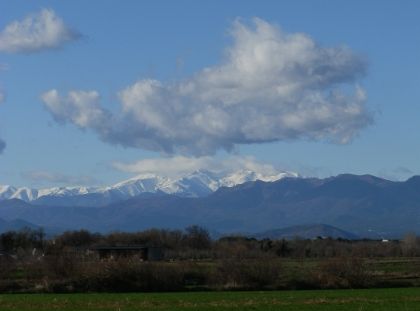 It would be fair to say, that for me, walking on the flat lacks variety and that would be the case here.
It would be fair to say, that for me, walking on the flat lacks variety and that would be the case here.
The scenery and views are great, but it doesn't change so much as we walk. The flat area also has a sharp wind blowing across the plain, so we decide just to walk to the hermitage of Sant Joan de Setcloses marked on the map. It's just a small white fronted chapel next to a large old masia and a farmyard with what look like Aberdeen Angus cattle, but it acts as a focus point for the walk.
From the chapel we walk across the fields and over a small ridge which gives and magnificent view of the mountain of Canigo and the Pyrenees, covered in snow rising above the plain.
We turn back, through the fields and along the ridge to Castello d'Empuries. As we enter the town, we find some walking information for a path that follows the Muga river.
We follow the path to the Muga as it wends it's way around the outskirts of Castello heading towards Empuriavbrava. The path is a broad passeo and passes an old bridge just behind the sports centre where we originally parked.
Neighbouring walks: Aiguamolls d'Emporda (Empuriabrava) - Sant Pere de Rodes - Figueres and Castell de Sant Ferran - Roses - Canyelles beaches to Cap Falconera - Cadaques to Roses - La Jonquera to Fort de Bellegarde (France) - Peralada
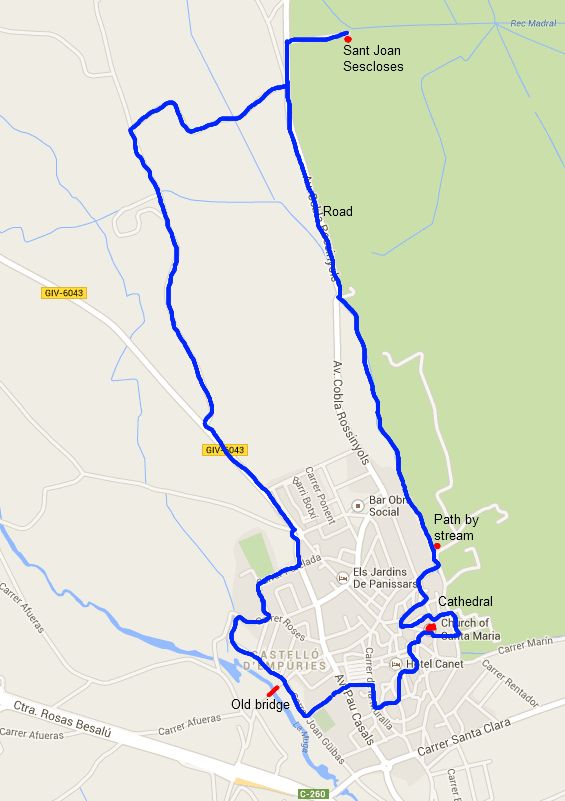
Begur, Ses Negres and Sa Riera
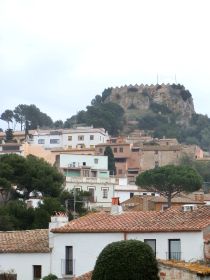 Begur is a popular area for people who come to the Costa Brava for walking. The town is on a hill which forms part of a headland that juts out into the Mediterranean leading down to a series of bays and beaches, such as Sa Tuna, Sa Riera or along to Fornells. It is possible to walk the entire headland in one go, but as we mentioned in the walk for Sa Tuna to Begur, our preference now is to make smaller loops, partly because the walks tend to be quite up and down.
Begur is a popular area for people who come to the Costa Brava for walking. The town is on a hill which forms part of a headland that juts out into the Mediterranean leading down to a series of bays and beaches, such as Sa Tuna, Sa Riera or along to Fornells. It is possible to walk the entire headland in one go, but as we mentioned in the walk for Sa Tuna to Begur, our preference now is to make smaller loops, partly because the walks tend to be quite up and down.
We've included Begur twice so far - the walk from Masos de Pals to Sa Riera via Begur, and the walk from Sa Tuna to Begur and back. This is effectively the missing bit of the triangle and takes us down to the coast along the Ses Negres Maritime Nature Reserve before returning via Sa Riera.
The first part of the walk to the Mirador de la Creu is largely a flatish walk from Begur centre into the woods and then gives fabulous views over the coast up towards L'Estartit and Roses, the Pyrenees and over the bay of Sa Tuna/Aiguafreda.
We start in the municipal parking just by the Parc d'Arbreda below the main part of Begur town, then wind our way through the back streets part some of the old mansions built by returning Catalan tobacco and sugar barons who had made their fortunes in the Carribean, to the start proper at the second junction of the circumval.lacio road that runs around the bottom of Begur town, just below the castle. Being the start of February, the weather can get cloudy and we have an overcast day, but despite that the views from the top are spectacular and we can still see all the way along the bay of Pals and Pals beach, beyond Montgri and up the coast to Roses and to the left we can just see the snow on the Pyrenees peaking out from behind the clouds.
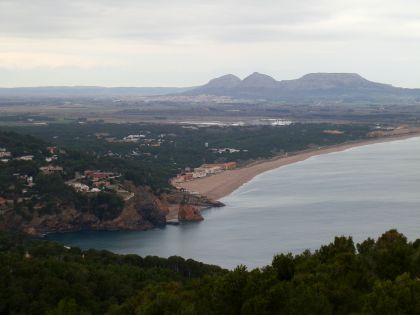 The walk we're taking is marked with green-white flashes and is one of the routes that is included on walking maps of Begur from the tourist information centre (senderismes). Having said that, a signpost would still be useful at the start and return points as you do have to look out for the green-white flashes.
The walk we're taking is marked with green-white flashes and is one of the routes that is included on walking maps of Begur from the tourist information centre (senderismes). Having said that, a signpost would still be useful at the start and return points as you do have to look out for the green-white flashes.
Leaving the town and the first small urbanisation we are quickly into the woods on a broadish track with an easy relatively level walk. The woods have signs of quarrying and stone extraction, but just make for a pleasant wooded walk. The flashes take us along a smaller track and we emerge on a quiet road by the first signpost. We have the option of going down towards Sa Riera, or a gentle upward slope to the Mirador de la Creu.
We go up to the Mirador to start, knowing that we will have to double back down. The mirador itself has parking nearby for those who aren't walking, and consists of a rocky outcrop on top of the hill which requires a half-scramble to get up. The views extend around almost 270 degrees, with Pals Beach and onwards to the North and the back of Aiguafreda/Sa Tuna beneath us to the south.
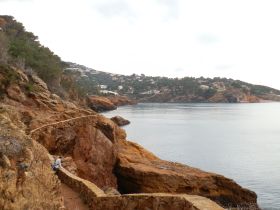 Having taken our fill of the view, we return along the road we came up, but this time we continue down towards the coast past the scattered holiday villas that have been built along the road. Bizarrely though the road is practically empty, there are old broken and rusted street lights all the way down. At the bottom we run into more houses and have the option of either heading down to Aiguafreda and Cap Sa Sal, or continuing around the hill to Ses Negres and we opt for the second option.
Having taken our fill of the view, we return along the road we came up, but this time we continue down towards the coast past the scattered holiday villas that have been built along the road. Bizarrely though the road is practically empty, there are old broken and rusted street lights all the way down. At the bottom we run into more houses and have the option of either heading down to Aiguafreda and Cap Sa Sal, or continuing around the hill to Ses Negres and we opt for the second option.
The road continues to curl downwards along the side of the hill and though we are walking on tarmacked road, it's quiet with no vehicles at this time of year. As we get lower, the green-white flashes indicate a side road to the left which at first glance looks like a dead-end. In fact there's a set of stairs that run past a house being built (technically the path was closed, but we ignored it - it'll be open again by the summer).
At the bottom of the stairs, we are on a concrete path with a small wall that runs above dark red/black rocks that stretch down to the sea 10-20m below us. These are Ses Negres - the black rocks - an unusual colour and shade for this part of the Costa Brava and almost orange like the Algarve in places. The area is a maritim nature reserve and we can see cormorant fledglings sitting on the rocks with their parents. We can see the Isla Medes up the coast and right across the bay we can see the Isla Roja and Platja de Pals.
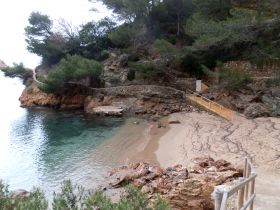 The path curls around the coastline, then returns to the road just behind some large sea-side villas with infinity pools looking out to sea. After a short bit of road-walking, the path returns to the rocks - you have to take care to look out for the green-white flashes as the signpost has been knocked down - and loops around to a small sandy bay by the side of the main Sa Riera beach. It's winter now and Sa Riera is largely closed up, but in summer the beach has dozens of small fishing boats lined up on the sand and holiday makers on the beach.
The path curls around the coastline, then returns to the road just behind some large sea-side villas with infinity pools looking out to sea. After a short bit of road-walking, the path returns to the rocks - you have to take care to look out for the green-white flashes as the signpost has been knocked down - and loops around to a small sandy bay by the side of the main Sa Riera beach. It's winter now and Sa Riera is largely closed up, but in summer the beach has dozens of small fishing boats lined up on the sand and holiday makers on the beach.
We walk through the couple of streets of what was a small fishing village before heading up the road past the newer holiday homes that have been built. We're looking for the footpath by the stream back up to Begur, and it's not very well marked unless you know what you're looking for (it's the same path we came down for the Masos de Pals-Begur walk). We have to head out on the road as if we're going out and then the second track to the left has the green-flash on the stop sign. This takes us along a track to the back of some houses and we continue up the steps at the end and across what looks like someone's garden - don't worry this is the right way.
 After the garden we have the stream to our left and the path follows the stream all the way back up to Begur with a series of small cascades and rockpools as we go up. At various points there are steps and the occasional deep well shaft for when the river runs dry. The only complication is crossing the road a couple of times, where you have to look for the green-white flashes to know where to continue - basically still along the stream.
After the garden we have the stream to our left and the path follows the stream all the way back up to Begur with a series of small cascades and rockpools as we go up. At various points there are steps and the occasional deep well shaft for when the river runs dry. The only complication is crossing the road a couple of times, where you have to look for the green-white flashes to know where to continue - basically still along the stream.
The route is up all the way, but it's a steady climb so not too arduous and being by the stream there are trees and grass areas, though it is quite long, emerging at the top by Parc d'Arbreda again.
Neighbouring walks: Fornells and Aiguablava walk (GR92) - Sa Tuna, Cap de Begur, Begur - Masos de Pals, Begur, Sa Riera and Platja de Pals
Swimming: Swimming and beach at Sa Riera (Begur) - Swimming and canoeing at Sa Tuna (Begur)
Events: Begur - Festa d'Indians
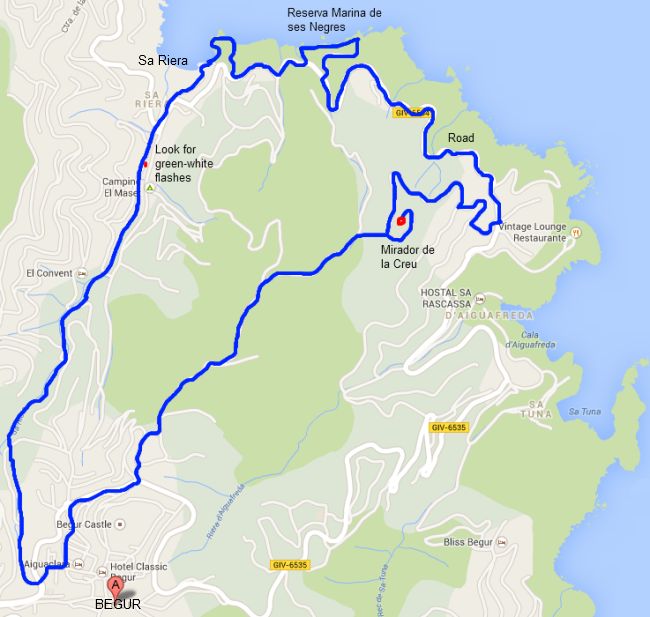
Perpignan (and rugby)
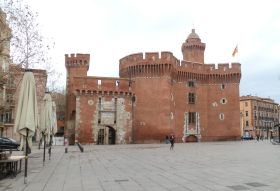 Perpignan is the closest French city to the Costa Brava and is reachable in about 80 minutes from where we live. In distance terms it's closer than Barcelona which means that when we want something special, travelling to France is another possibility.
Perpignan is the closest French city to the Costa Brava and is reachable in about 80 minutes from where we live. In distance terms it's closer than Barcelona which means that when we want something special, travelling to France is another possibility.
Perpignan itself was originally an important Catalan town, part of the old Catalan county of Roussillon and only became French in 1659. As a result modern Perpignan and the local area style themselves as being part of Catalunya Nord with signs in both French and Catalan (not Spanish) and there is a strong affinity for Catalonia. However, it also has a strong French feel and there is definite change when you cross the border.
One of the visible changes is that you see rugby posts in the sports fields. Like many places in the south of France, people around Perpignan are fanatical about rugby and Perpignan itself has not one professional rugby team, but two. For rugby union there is the USAP (Union Sportive des Arlequins de Perpignan) who play in the French premier rugby league (Top 14), and for rugby league the Catalan Dragons who play as the only non-English club in the Super League for rugby league.
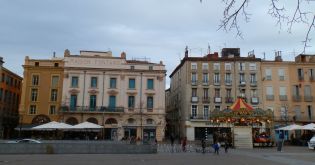 Coming from the West Country, I was brought up on rugby rather than football and as it happens Gloucester, which used to be our local rugby club was playing Perpignan in the pan-European Heineken Cup competition so this was a chance to get to see my old home team once more.
Coming from the West Country, I was brought up on rugby rather than football and as it happens Gloucester, which used to be our local rugby club was playing Perpignan in the pan-European Heineken Cup competition so this was a chance to get to see my old home team once more.
Unfortunately on the Spanish side of the border, rugby is still very much a minor sport in Catalonia. There is only one club for the Costa Brava - Senglars in Torroella de Montgri, and there is one in Girona. Barcelona has more across the city, and is trying to increase participation with help from USAP, and about four years ago, USAP came down to Barcelona to play Toulon in the Heineken cup at the Olimpic Stadium with 55,000 spectators, much to the city's surprse.
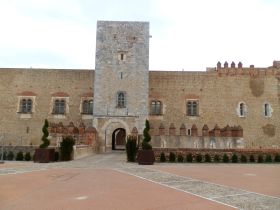 Before we watched the rugby, we took a brief walk around the main town. It's actually a place we visit reasonably often. The shopping is different from the Spanish side of hte border - many French products don't make it across the frontier and there is generally a better selection of produce, and a different selection of goods and a different style and range and though prices tend to be a little higher in France, there are still some bargains for cross-border consumption.
Before we watched the rugby, we took a brief walk around the main town. It's actually a place we visit reasonably often. The shopping is different from the Spanish side of hte border - many French products don't make it across the frontier and there is generally a better selection of produce, and a different selection of goods and a different style and range and though prices tend to be a little higher in France, there are still some bargains for cross-border consumption.
We parked near the rugby stadium (Aime Giral) which is to the south of the city and about a 7-8 minute stroll to the city centre. As we were walking up into town, lots of cherry-and-white Gloucester supporters were walking towards the stadium the other way. One tradition with many rugby teams, and USAP is no different, is that there is hospitality for visiting fans through the morning and the stadium itself has a number of bars and lounges for eating around the bottom for members and visitors.
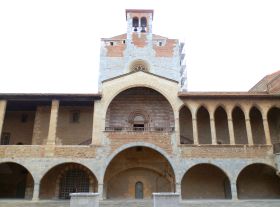 Our route took us over the river (the Tech) and then into town in front of the Castillet. This is a large red-brick castle/town gate that marks the entrance to the old city area. This is just across the canalised river Basse. From this point a network of old streets and buildings form the heart of the old town, most of which have been converted to plush shops or restaurants. There is plenty to explore, but we walk through the older section to emerge by the Place de la Republic, a large square with a merry-go-round in it and bars and restaurants all around.
Our route took us over the river (the Tech) and then into town in front of the Castillet. This is a large red-brick castle/town gate that marks the entrance to the old city area. This is just across the canalised river Basse. From this point a network of old streets and buildings form the heart of the old town, most of which have been converted to plush shops or restaurants. There is plenty to explore, but we walk through the older section to emerge by the Place de la Republic, a large square with a merry-go-round in it and bars and restaurants all around.
We then head upwards in terms of height in among the smaller streets of houses. Unfortunately the houses and area is a little run down and there is dog-mess all over the pavements (a problem we found all over Perpignan). Going up we reach the outer walls of the great Vauban fortification that surrounds the Palace of the Kings of Majorca - another ciutadella or fort construction built as a response to the annexation of this part of Catalonia in the 17th century.
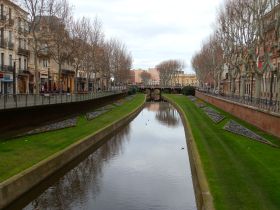 The walls, like the other forts in Catalona - Salses, Figueres, Roses, Girona, are massive and we skirt around the outside to find the entrance. The scale of the building is surprising - particularly as it took us several visits to realise it was there. But it doesn't stop. A gate passes through the outer walls and a broad flight of shallow steps runs up inside the wall emerging at an open level giving great views over the city and out to the mountains of Corbiere towards Narbonne, and to Canigou and the Pyrenees.
The walls, like the other forts in Catalona - Salses, Figueres, Roses, Girona, are massive and we skirt around the outside to find the entrance. The scale of the building is surprising - particularly as it took us several visits to realise it was there. But it doesn't stop. A gate passes through the outer walls and a broad flight of shallow steps runs up inside the wall emerging at an open level giving great views over the city and out to the mountains of Corbiere towards Narbonne, and to Canigou and the Pyrenees.
But we're not finished. Another shallow set of steps reaches the top and we reach the topmost building - the Palace of the Kings of Majorca - a much older Catalan castle/palace built when Jaume II King of Majorca (and son of the King of Aragon) made Perpignan the capital of the Kingdom of Majorca in 1276. We go inside just to take the picture, but we're on a schedule for the rugby so we don't have time to visit more thoroughly this time.
We walk back down into the old city and out past the Palais de Justice and along the canalised river back towards the stadium. Being a Sunday a few food places are open but all the main shopping is closed. On a Saturday this is a thriving shopping area with all the standard French high-street stores like Fnac.
And so to the rugby. What might be surprising is that USAP's club song is sung in Catalan, a Lluis Llach standard that our children learnt in school here. The game is good natured with calls of USAP matched by the sound of visiting supporters chanting Glo..st..er in the long west country accent. Gloucester won 18-36.
See also: Andorra La Vella - Figueres and Castell de Sant Ferran - Girona - Festa Major of Sant Narcis - Puigcerda and Bourg-Madame - Cadaques and Port Lligat
Also in France close to the Costa Brava
White water rafting in Quillan (France) - Collioure (France) - Villefranche-de-Conflent and Mont-Louis (France) - Elne (France) - Ceret (France) - Andorra La Vella
Corça, Planils and Cassa de Pelras
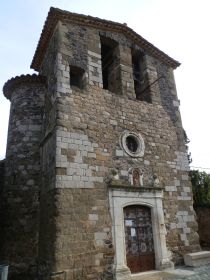 Corça is one of the Costa Brava villages from La Bisbal d'Emporda in the direction of Flaça (for the train station) and on to Girona. The old village is set back from the road and it would be easy to miss just our full of charm and character it has as you rush past in the car. We've walked from Corça on the northern side of the village (Corça, Casavells, Matajudaica). This was an opportunity to fill in a gap out towards Pubol and Flaça.
Corça is one of the Costa Brava villages from La Bisbal d'Emporda in the direction of Flaça (for the train station) and on to Girona. The old village is set back from the road and it would be easy to miss just our full of charm and character it has as you rush past in the car. We've walked from Corça on the northern side of the village (Corça, Casavells, Matajudaica). This was an opportunity to fill in a gap out towards Pubol and Flaça.
We start on the Sant Cristina side of the road and park by the Sala Municipal.
In contrast to the old village on the other side of hte main road, the Sant Cristina side of Corça is a residential area mainly made up of modern housing in a mix of terraces and detached houses on a small hill with views back to La Bisbal and up to the Gavarres above Monells so not too much to see.
We head to the top of Sant Cristina and then onto a track that runs past a football field. At the far side of the football field we take a left following the diret track that is signed as the bike route for Pubol. (For most of this walk we found ourselves on bike routes, but mostly off road).
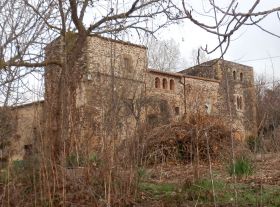 We wander down the track with a field on one side and woods on the other before crossing a small stream on stepping stones. The path then emerges at a small tarmacked road by a farmhouse. The road is very very quiet so there is no problem following it along a small stream past fields and the occasional copice of birch trees. At one point we see a deep shaft just by the side of the road and looking on the map it seems this was once an area used for mining - though there is little other evidence.
We wander down the track with a field on one side and woods on the other before crossing a small stream on stepping stones. The path then emerges at a small tarmacked road by a farmhouse. The road is very very quiet so there is no problem following it along a small stream past fields and the occasional copice of birch trees. At one point we see a deep shaft just by the side of the road and looking on the map it seems this was once an area used for mining - though there is little other evidence.
The road is rural and quiet and we reach a collection of three or four large masias that make up the hamlet of Planils, first two next to each other, then a third which looks older with towers like a castle a little further on. We're still on tarmac and just after the last masia a dirt track goes to the left and the map shows a more off road route. So we follow the track and then head into the woods a little further on.
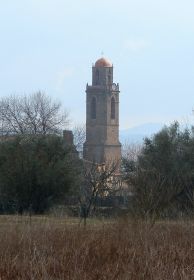 We continue through the woods for about a kilometre following sheep tracks in the soft soil, until the track reaches a tarmac road again where we turn right. We go down and then up the other side of a valley to the first of the masias of Cassa de Pelras. The masias here are large in a slighly darker stone with few windows to the road so they look quite intimidating. At the masia we turn left, then take the next right - again a track - which takes us to the cluster of buildings around the church.
We continue through the woods for about a kilometre following sheep tracks in the soft soil, until the track reaches a tarmac road again where we turn right. We go down and then up the other side of a valley to the first of the masias of Cassa de Pelras. The masias here are large in a slighly darker stone with few windows to the road so they look quite intimidating. At the masia we turn left, then take the next right - again a track - which takes us to the cluster of buildings around the church.
The church is small and there is a slightly odd bank of three stairs separate from the church (made in 1908 according to the plaque on it), that would have been used by musicians for village fesitvities in older times. It's worth walking around the church as there are two small plaças in an area that only has about three buildings. Cassa sits on top of a ridge which separates the valleys of the river Daro (La Bisbal's river), from the valley of the river Ter.
From Cassa we head slightly north to meet the main C66 road - this is to reach another footpath and avoid walking along the busy road. We reach the bus stop and cross then take the path to the right of the house in front of us. We're in fields again and there are views now to the north across the Empordan Plain and across to Montgri.
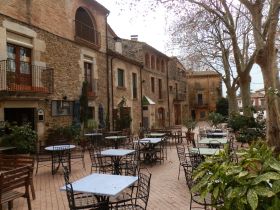 As we approach an old farmhouse we notice on the map that our next path is actually very close, so we try cutting through the farmyard to make the connection. Unfortunately we can't find a route through, but some neighbours walking dogs show us a route that involves jumping over two walls to reach the path and road on the other side. On our map, we'd recommend taking the genuine dotted line path.
As we approach an old farmhouse we notice on the map that our next path is actually very close, so we try cutting through the farmyard to make the connection. Unfortunately we can't find a route through, but some neighbours walking dogs show us a route that involves jumping over two walls to reach the path and road on the other side. On our map, we'd recommend taking the genuine dotted line path.
We are now back on a cycle path and a gentle down hill walk through a mix of fields and woods down to Corça, emerging at the main C66 a little ahead of the village just by the Mas Pastor restaurant. However, we don't have to walk along the road as there's a separate path back to the village that connects to a small road towards the older heart of Corça.
We've described the older part of Corça before, but it remains an interesting and intriguing village of terraced houses and an inner walled centre. On the side of the village closest to the road is a delightful square with plane trees just by the river and restaurants and cafes (quiet when we went past).
We cross the road via the underpass under the school and get back to the car.
Neighbouring walks: Corça, Casavells, Matajudaica - La Bisbal, Vulpellac, Castell d'Emporda, Fonteta - Rupia and Foixa - Cruilles, Monells and Sant Sadurni de l'Heura - La Pera, Pubol and around - Madremanya, Els Angels, Sant Marti Vell
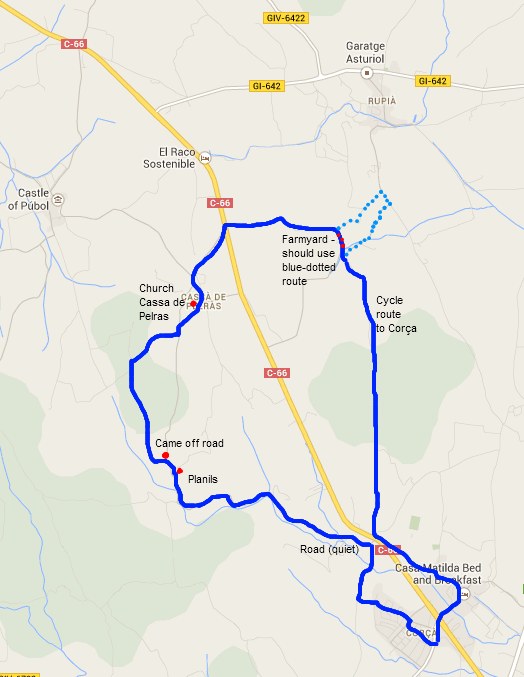
Girona valley of Sant Daniel
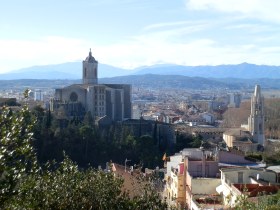 During the walk last year that we did up to the castle of Sant Miquel in the Gaverres (Girona and Castell de St Miquel), we didn't take any photos. This is a short walk in to the valley of Sant Daniel behind the cathedral. For its proximity to the city, it's still amazing to think how quickly you can get into open countryside and farms and rural buildings.
During the walk last year that we did up to the castle of Sant Miquel in the Gaverres (Girona and Castell de St Miquel), we didn't take any photos. This is a short walk in to the valley of Sant Daniel behind the cathedral. For its proximity to the city, it's still amazing to think how quickly you can get into open countryside and farms and rural buildings.
We took the northern road into Girona down past Pont Major towards the centre and parked by the river just below Montjuic to save having to navigate Girona's one-way system. From here we walked under the railway into the older part to where the old walls meet the road up to Montjuic (and up to Girona's Ciutadella). We then head up on the right hand side of the Sant Daniel valley to the Jardins de John Lennon which climb up to the city wall. At the top is a gap in the wall with signposting to the Torre Sutxet and viewpoint as there are excellent views across to the cathedral.
We follow the path past the old tower, then along the side of the hill as it curves around the corner giving views out to the Gavarres. The path curls around to the head of the next valley and some executive housing and we come down the hill past a farm and in towards the Monastery of Sant Daniel.
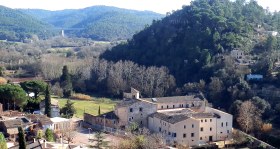 Crossing the stream at the bottom through a small park we start going up past a small font and then follow a dirt track up to the top of the cathedral side of the valley and along to the city walls. Finding an appropriate point through the walls we can then enter the old city from close to the Casa del Alemanys. When the city was founded in Roman times the wall from Alemanys down to the Cathedral would have been the extent of Girona on this side, and from Alemanys down the lane, the left hand extent of what was a tiny triangular city by comparison to today.
Crossing the stream at the bottom through a small park we start going up past a small font and then follow a dirt track up to the top of the cathedral side of the valley and along to the city walls. Finding an appropriate point through the walls we can then enter the old city from close to the Casa del Alemanys. When the city was founded in Roman times the wall from Alemanys down to the Cathedral would have been the extent of Girona on this side, and from Alemanys down the lane, the left hand extent of what was a tiny triangular city by comparison to today.
Not a long walk, but something to provide a different perspective to Girona to the old streets and modern shops.
Neighbouring walks: Girona and Castell de St Miquel - Girona - Festa Major of Sant Narcis - Celra, Juia and the Castle of Palagret - Roman fort at St Julia de Ramis (Girona) - Girona cyclepath to the coast - Bescano, River Ter and free-style kayaking - Girona Temps de Flors
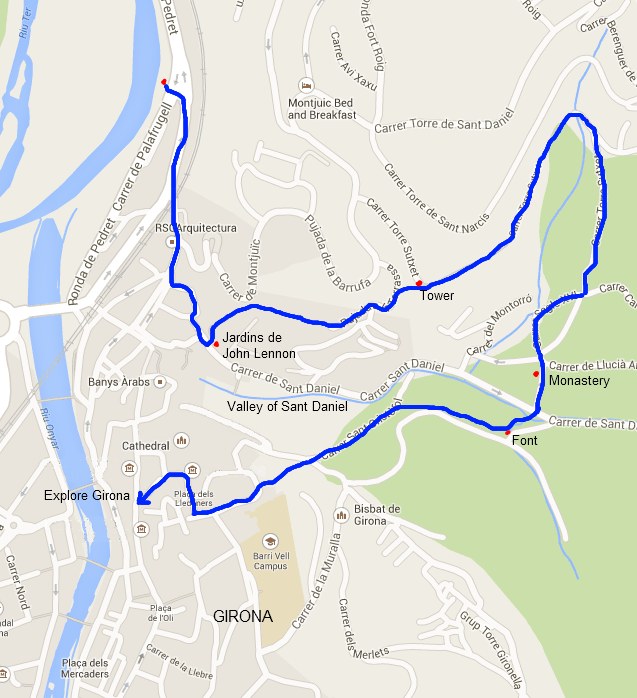
Figueres and Castell de Sant Ferran
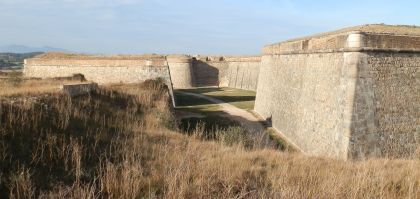 Figueres is the second major inland town for the Costa Brava after Girona. It is also the first main Catalan town from France and so has something of a border-town feel to it with a blend of cross-border shopping and the feeling of a French influence.
Figueres is the second major inland town for the Costa Brava after Girona. It is also the first main Catalan town from France and so has something of a border-town feel to it with a blend of cross-border shopping and the feeling of a French influence.
As a town, Figueres is most famous as the location of the Dali Museum - an elaborate surrealist palace created by Dali from the old theatre in Figueres.
For visitor to Figueres, the town is somewhat ecletic.
The Dali Museum is excellent and strongly worth visiting, both from the outside with eggs and golden figures perching above the museum walls and scupltures balanced on columns of tyres, or from the inside where you can see paintings, sculptures and jewelry by Dali (though not the most famous Dali painting - 'The Persistence of Memory' with the melting watches).
Around the museum area is a small network of streets with fancy shops and restaurants almost in a French style, and there is a large Rambla and market nearby.
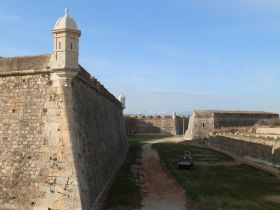 However, outside the heard of the town Figueres can appear a little drab with lots of oversize apartment blocks built in an 1970s style, with the classic Spanish style of tall buildings with empty panelled walls waiting for the neighbouring buildings to fill in the gaps.
However, outside the heard of the town Figueres can appear a little drab with lots of oversize apartment blocks built in an 1970s style, with the classic Spanish style of tall buildings with empty panelled walls waiting for the neighbouring buildings to fill in the gaps.
In general, it feels like the town is improving over time, but the process seems slow and there are still unkept corners.
Away from the main town centre, there are larger shopping centres and retail parks out towards Roses.
The French influence can be felt and there is usually some different shopping than in Girona or further south with more products, visitors and French home-owners close to Figueres and across to Roses.
 As an aside, in general the range of products in Catalan supermarkets is lower than for the UK or France and it can be difficult to find certain product lines, or where they do exist they can be very expensive and occasionally we need to go to France to find certain products because they aren't common or popular in Spain.
As an aside, in general the range of products in Catalan supermarkets is lower than for the UK or France and it can be difficult to find certain product lines, or where they do exist they can be very expensive and occasionally we need to go to France to find certain products because they aren't common or popular in Spain.
To us it's always a surprise at how little French food crosses the border. So we often go to France to stock up on cordials and squash, or to find joints of meat, duck, and at Christmas a range of traditional Christmas foods including turkeys (though they can be found here if you know where to look), spices and certain herbs or food ingredients, or certain types of electrical goods.
For other visitors, Figueres now also boasts two train stations - the main station is the older slow line that connects to Port Bou to the north on the French border and to Girona and Barcelona to the south. This is relatively close to the centre - to get to the Dali Museum is just a trip across the market square, and around the corner and one street further on.
 The second station is the brand new station for the modern high-speed AVE line at Vilafant that links Perpignan through the tunnel through the Pyrenees to Barcelona and then Madris with TGV type trains (Paris is about 5 hours away).
The second station is the brand new station for the modern high-speed AVE line at Vilafant that links Perpignan through the tunnel through the Pyrenees to Barcelona and then Madris with TGV type trains (Paris is about 5 hours away).
Though the Vilafant station is a little further out compared to the main station, it's still only about 1.5km from the centre of Figueres.
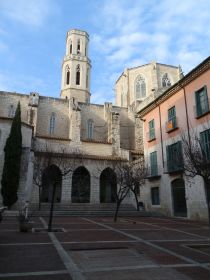 The main reason of our visit though was to see the Castle of Sant Ferran (Ferdinard in Spanish). This is obviously less well known than the Dali Museum, but really would count as the second tourist attraction,
The main reason of our visit though was to see the Castle of Sant Ferran (Ferdinard in Spanish). This is obviously less well known than the Dali Museum, but really would count as the second tourist attraction,
The Castle is low sunk fortress that sits on the hill above Figueres behind the hospital. It's very very big - more than 3km to walk all around the outside with large brick and earthwork walks built in a complex pattern of triangles and bastions.
It dates from 1750s, built in response to the loss of the Chateau de Bellegarde at Le Perteus in the 1690s after a series of wars and skirmishes between the French and Spanish in the 17th Century including an independent Catalonia under Pau Claris with French protection.
For historical context, this was the time of Louis XIV and the scheming Cardinal Richlieu of Three Musketeers fame.
Unfortunately when we arrived the main central part of the castle was closed.
The times outside said the castle should be open until 3pm, but it seemed to allow the last visitors in just after 2pm. As a result we had to make do with looking in at the castle from the path that runs around the outside
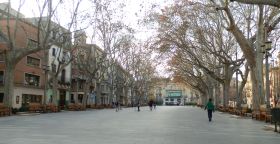 Having only seen the outer walls from the Autopista were the castle seemed a little neglected, in fact close up the castle is well maintained.
Having only seen the outer walls from the Autopista were the castle seemed a little neglected, in fact close up the castle is well maintained.
The low defensive structures that give this impression as the castle is built into the ground almost reminiscent of a neolithic fort with deep gullies and lines of brick-faced earthenwork walls.
At the time it was constructed, the power of cannon offenses and the growing size of armies meant the older tall keep and high walled medieval castles that are common in the UK, were too easily breeched.
And while the UK broadly stopped building castles in Tudor times, moving instead to more stately homes, on the continent borders, invasions and rebellions remained a real possibility (in the UK, the ports defences are probably the most similar to the massive earthwork forts than can be found in Catalonia).
Ciutadellas and massive forts can be found at Salses, Mont-Louis and Confluent in French Catalonia, and at Roses, Girona and Barcelona in addition to Figueres on the Spanish side of the border.
 The castle itself is enormous. It's takes 30-40 minutes to walk the 3km around the walls and we saw several people using it as a jogging route. (By way of contrast Warwick Castle is approximately 420m around the walls.)
The castle itself is enormous. It's takes 30-40 minutes to walk the 3km around the walls and we saw several people using it as a jogging route. (By way of contrast Warwick Castle is approximately 420m around the walls.)
More surprising were the views from the castle with clear views to Roses (which has it's own enormous Ciutadella) and up to Bellegarde on the pass to France.
The location close to the French border also made it an important staging post for the mass exodus of people as they fled the Spanish Civil War.
The castle itself was the site of the last meeting of the Republican government prior to Franco's victory.
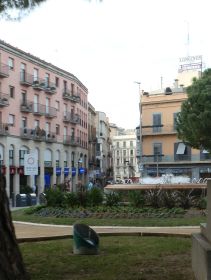 From the viewpoint the road runs straight down to the Dali Museum in the town.
From the viewpoint the road runs straight down to the Dali Museum in the town.
The Dali theatre museum is a mix of extravagancies with a glass sphere, giant white eggs and golden figures rising above pink walls that have yellow elements that look like brioche loafs studding the wall.
The museum sits in the centre of the town in a former theatre, very close to the church and there is a contrast with the plainer white architecture of the main Figueres church.
The main entrance is via a placa behind the church full of curiosities and sculptures which the main entrance clearly showing the buildings' heritage as an old theatre.
Dali himself built the museum in the 1960s so it's very much a homage to his vision, rather than a collectors type museum, and that makes it much more fun. We've visited several times but didn't go in this time.
Around the Museum area, are smart streets with shops and restaurants that eventually lead to the main Rambla - a very broad promenade in the centre of the town.
From here, the last area to see is the market area which joins the street at the bottom of the Rambla in the direction of the main (older) station with more sculptures and a floating cover for the market.
See also: Girona (Festa Major of Sant Narcis) - Peralada - Visit to Besalu and Banyoles - La Jonquera to Fort de Bellegarde (France) - Llança - Cadaques and Port Lligat - Port de la Selva - Sant Pere de Rodes - Roses and Roses Ciutadella - Waterfall at Les Escaules (Boadella) - Girona valley of Sant Daniel
Celra, Juia and the Castle of Palagret
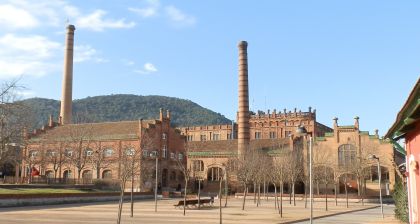 Travelling from Girona to La Bisbal on the C66 route to the Costa Brava, the road and railway line passes through Celra, Bordils and then to Flaça. From the main road, the towns look as if they are just a line of houses and shops built along the road and so seem quite plain motor suburbs for Girona. In fact, as with many towns in Catalonia, the view from the main road is deceptive. All of the towns are actually based around much older village centres, but each centre itself is around one to two kilometres away from the main road and away from the Barri d'Estacio - the estates, modern buildings and industrial units located close to the train station. For instance, many people who catch the train to Flaça to connect to the Costa Brava don't realise that there is actually an older and more interesting part to the town which is separate from the main station area.
Travelling from Girona to La Bisbal on the C66 route to the Costa Brava, the road and railway line passes through Celra, Bordils and then to Flaça. From the main road, the towns look as if they are just a line of houses and shops built along the road and so seem quite plain motor suburbs for Girona. In fact, as with many towns in Catalonia, the view from the main road is deceptive. All of the towns are actually based around much older village centres, but each centre itself is around one to two kilometres away from the main road and away from the Barri d'Estacio - the estates, modern buildings and industrial units located close to the train station. For instance, many people who catch the train to Flaça to connect to the Costa Brava don't realise that there is actually an older and more interesting part to the town which is separate from the main station area.
We mentioned Celra's modernista factory in our walk around Sant Julia de Ramos and we'd not visited Juia before this weekend, so it was a chance to explore up into a different part of the Gavarres, so needing to be in Bordils for a sports tournament we decided to take the opportunity to explore Celra and Juia.
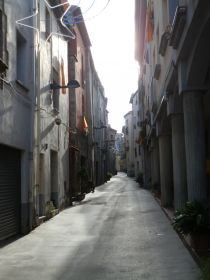 We parked and started in Celra just by the station and the old modernista factory. The factory itself (La Fabrica) is built in red brick with large windows and two old chimneys and is reminiscent of the harbour buildings on Gloucester old docks. It was a chemicals factory in the past originally for chemicals for the tanning industry, but it's now been coverted into a social centre, town library, and is also the location of an outdoor municipal swimming pool.
We parked and started in Celra just by the station and the old modernista factory. The factory itself (La Fabrica) is built in red brick with large windows and two old chimneys and is reminiscent of the harbour buildings on Gloucester old docks. It was a chemicals factory in the past originally for chemicals for the tanning industry, but it's now been coverted into a social centre, town library, and is also the location of an outdoor municipal swimming pool.
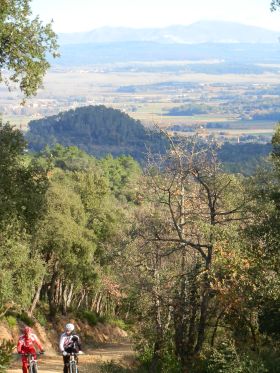 We walked from the station up towards the old town and into the nucleas of older buildings just along from the town theatre - a building in an 1930s style, so probably from that time. The inner part of the town is much older with stone built buildings along narrow streets that curl around to the church. The older part seems quite large for a village suggesting that the older town would have been an important centre at one point. We follow the older alleys up towards the higher parts just under the Gavarres Hills past horta (vegetable gardens) and lemon trees. On the outskirts is more of a mix of older and more modern houses that look well-appointed for commuters to Girona, and then large masias dotted about looking over the fields around the village.
We walked from the station up towards the old town and into the nucleas of older buildings just along from the town theatre - a building in an 1930s style, so probably from that time. The inner part of the town is much older with stone built buildings along narrow streets that curl around to the church. The older part seems quite large for a village suggesting that the older town would have been an important centre at one point. We follow the older alleys up towards the higher parts just under the Gavarres Hills past horta (vegetable gardens) and lemon trees. On the outskirts is more of a mix of older and more modern houses that look well-appointed for commuters to Girona, and then large masias dotted about looking over the fields around the village.
Our path continues up past Mas Castell, a square built masia with a tower in the center, its stonework fully restored and golden in the sun. Around the side of the mas the path heads up into the woods and we find our first signpost. We can either continue up, or take the track marked to Juia down by the stream. We follow the path to Juia, but soon take a right hand turn up the hill on a broad forestry track. This is an area popular with mountain bikers and every so often one or two come downhill past us.
The path continues up and as we climb we can see the castle of Sant Miquel on the neighbouring ridge (see Girona walk). We continue an easy-going climb through the woods, with views back across the plain of the Ter and the factory buildings of Celra behind us.
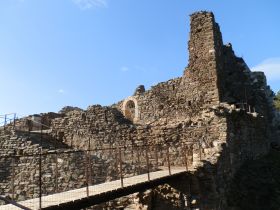 After what seems a longer time than we were expecting and almost at the top of the hill, our track joins with another broader path at a fork. We turn to the left down the track just a two mountain bikers are coming up - it seems like a long climb, but they don't seem to notice. This path will lead us down to the castle and the views are excellent, firstly out to the sea and Montgri and then across to the Pyrenees - a line of snow clearly visible, with the top of Canigo shrouded in cloud.
After what seems a longer time than we were expecting and almost at the top of the hill, our track joins with another broader path at a fork. We turn to the left down the track just a two mountain bikers are coming up - it seems like a long climb, but they don't seem to notice. This path will lead us down to the castle and the views are excellent, firstly out to the sea and Montgri and then across to the Pyrenees - a line of snow clearly visible, with the top of Canigo shrouded in cloud.
The path takes us down the next valley from the one we walked up with the Sanctuari of Els Angels on top of the hill opposite. Close to the bottom the road takes a right hand bend and we get to the ruins of the castle of Palagret. Little more than a few walls and some arched door ways remain of the building which sits above a moat hewn out of the rocks. The castle is being renovated and a wooden bridge with metal handrails takes us into the main keep area. Other stairs have been added and it's possible to walk through the rooms and up to the top of the castle for the view of the valley.
After a brief break we continue the last part of the downhill and on past some terraced fields and a stream close to old masias. We could walk straight back to Celra, but our planned route takes us along the Cami de Juia to the right. As we pass the last gate before returning to the woods we see what looks like a dragon's nest made from reeds wrapped around two trees obviously made for children.
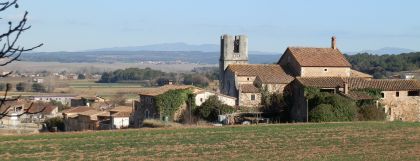 The path curves through the woods and then gently rolls down to the old village of Juia emerging at an imposing farmhouse with views of the church. Juia is a small village/hamlet almost all of original older stone houses nestling together along a small streamway.
The path curves through the woods and then gently rolls down to the old village of Juia emerging at an imposing farmhouse with views of the church. Juia is a small village/hamlet almost all of original older stone houses nestling together along a small streamway.
The path back to Celra follows the road, but is separated as a combined footpath, cyclepath and bridleway and we pass more perfectly restored farmhouses. At the outskirts of Celra we are back among more modern buildings and a number of apartment blocks as the outskirts of Celra is more modern with estate type houses. Then along past the older centre once more and back to the car.
Neighbouring walks: Girona and Castell de St Miquel - Roman fort at St Julia de Ramis (Girona) - Madremanya, Els Angels, Sant Marti Vell - Bordils and the tree plantations of the Ter - Rupia and Foixa - Sant Jordi Desvalls, Colomers and Sant Llorenç de les Arenes
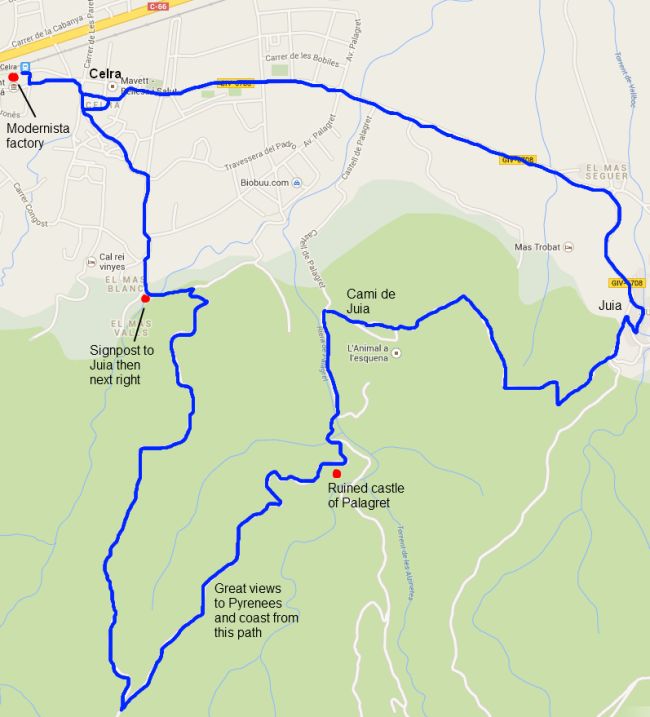
Canet d'Adri
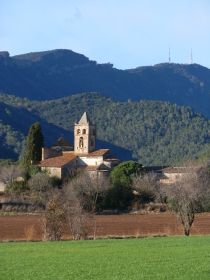 Canet d'Adri sits in the hills behind Girona that separate Girona from Olot and includes the outskirts of the Garotxa, the land of ancient volcanoes formed when the Spanish Penisular (which is geologically part of Africa) ran into the European continental plate.
Canet d'Adri sits in the hills behind Girona that separate Girona from Olot and includes the outskirts of the Garotxa, the land of ancient volcanoes formed when the Spanish Penisular (which is geologically part of Africa) ran into the European continental plate.
It's an area we haven't explored very much, so a bright sunny Boxing Day seemed a good chance to walk off Christmas Dinner and to try off a new walking map of the Girona area from the ICC and it happens there's a 'green star' on the map indicating 'natural curiosity, beauty spot' - the Gorgues de la Font de la Torre.
Walking a new area without really knowing what the routes are is always interesting - sometimes it's just pot luck as to whether we find something worth visiting or just discover there would be somewhere better to walk for next time. We park just across the road from the old Ajuntament building and walk down the lane towards the river. The map marks two bridges as being of interest and we walk down to the first one. The bridge isn't so interesting, but it sits above a rocky gorge. From the map we had wondered if we could make a route along the river, but the path is marked as private, so we have to go back up towards the village and follow the official footpath past mainly newer houses and a new looking sports centre.
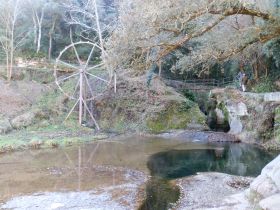 The path down to the Font de la Torre is easy to find beneath a large old almost warehouse-looking masia, and steps take us down to rocky pools, waterfalls and two streams cutting through the rock in narrow gorges. The area is obviously popular and metal rails run along side the paths. On the opposite corner is a large waterwheel standing above the water now as decoration rather than a working wheel and some of the pools are deep and clear with vertical sides. Under an old bridge, the streams fall away in a series of water falls down through the cut to a river below.
The path down to the Font de la Torre is easy to find beneath a large old almost warehouse-looking masia, and steps take us down to rocky pools, waterfalls and two streams cutting through the rock in narrow gorges. The area is obviously popular and metal rails run along side the paths. On the opposite corner is a large waterwheel standing above the water now as decoration rather than a working wheel and some of the pools are deep and clear with vertical sides. Under an old bridge, the streams fall away in a series of water falls down through the cut to a river below.
Having chased across the rocks and pools and along the streams, we decide to try to follow the stream at the back into the woods and hills. The path is narrow and haphazard and we skip across the rocks to the other side of the stream to try to find a better route, but the path is the same. The sides are initially like walls but with large ferns growing out of them giving the path a jurassic feel.
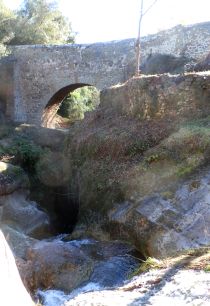 As we continue, we're not so sure if the path we're walking really is a path and not wanting to get too deeply into the woods and hills as this is a relatively remote area with few roads or routes, we find a path up the side of the stream to the right and reach a forestry garage/picnic area and a track that takes us out to the road close to Can Canet.
As we continue, we're not so sure if the path we're walking really is a path and not wanting to get too deeply into the woods and hills as this is a relatively remote area with few roads or routes, we find a path up the side of the stream to the right and reach a forestry garage/picnic area and a track that takes us out to the road close to Can Canet.
We take the track back down before taking a left towards Can Nadal (it is Christmas). This looks like a colonies house and as we get closer we follow the sign that points to Administracio and up into the woods. The idea for the second part of the walk is to visit the old volcano just behind Canet d'Adri, but the paths aren't too clear. We follow the track at the back of Can Nadal into the woods until it emerges at a newly ploughed field.
Someone has driven across the field and so there is a track, and the track exists on the map so we chance it and reach the woods up on the far side. The path takes us past Can Pou (Pou is a well in Catalan), through the woods and out at more of a road on the other side. As we emerge we see the sign from the road says the track we were on was a Pas Particular - a private road. This is something we find regularly - an open path from one end is marked as private from the other. Unfortunately the maps don't distinguish between private and public tracks or routes.
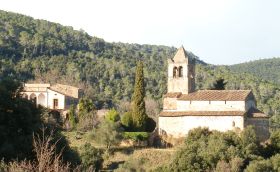 We continue down the road to the back of the volcano. As we reach the junction we see the signpost for a bigger walk up to Rocacorba and Puigsou. Looking up we can see the arial masts above the cliffs on top of the mountain behind us - so something for another day. We're at the back of the Puig of the old volcano and there are several families walking so we follow the road around the back of the Puig (it means 'hill' in Catalan). There are many isolated masia farmhouses and as is common around Girona, several have been restored as large family restaurants. Sunday lunch at a country masia is very popular for locals - much more than going to the coast or eating in town.
We continue down the road to the back of the volcano. As we reach the junction we see the signpost for a bigger walk up to Rocacorba and Puigsou. Looking up we can see the arial masts above the cliffs on top of the mountain behind us - so something for another day. We're at the back of the Puig of the old volcano and there are several families walking so we follow the road around the back of the Puig (it means 'hill' in Catalan). There are many isolated masia farmhouses and as is common around Girona, several have been restored as large family restaurants. Sunday lunch at a country masia is very popular for locals - much more than going to the coast or eating in town.
We keep following the road around to Adria a small hamlet of large old houses and a small church that stands above a wooded valley. In the distance we can look out to Girona and the Gavarres. The houses are built in the traditional golden stone of the region and many have been fully restored.
Though there is a route up to the puig, according to the map there are no routes over the puig and down the other side so we stick to the road as it curves around the base of the Puig finding rocks of pumice along the side of the road. We pass through woods and have more views towards Girona and see the newly erected pylons for the MAT electricity line that is going to be bringing electricity from France as far as Barcelona. MAT (Molt Alta Tensio) is controversial because of the visual impact of the pylons and lines and there are many 'no-MAT' signs and posters in this part of Girones. This is the first time we've actually seen the pylons and they are larger than normal, but not the only pylons in the landscape.
Around the hill we return to Canet d'Adri. We would normally visit the village centre and church, but the older part of the village looks to be just the church and a house, so we return to the car and back towards Girona.
Other visits: Arbucies autumn walk - Visit to Roda de Ter and Espinelves - Visit to Setcases - Visit to Besalu and Banyoles - Serinya and Illa del Fluvia - Banyoles lakeside walk - Sant Miquel de Fluvia - Bascara - horses, fords and lost - Cervia de Ter - Waterfall at Les Escaules (Boadella)- Bescano, River Ter and free-style kayaking
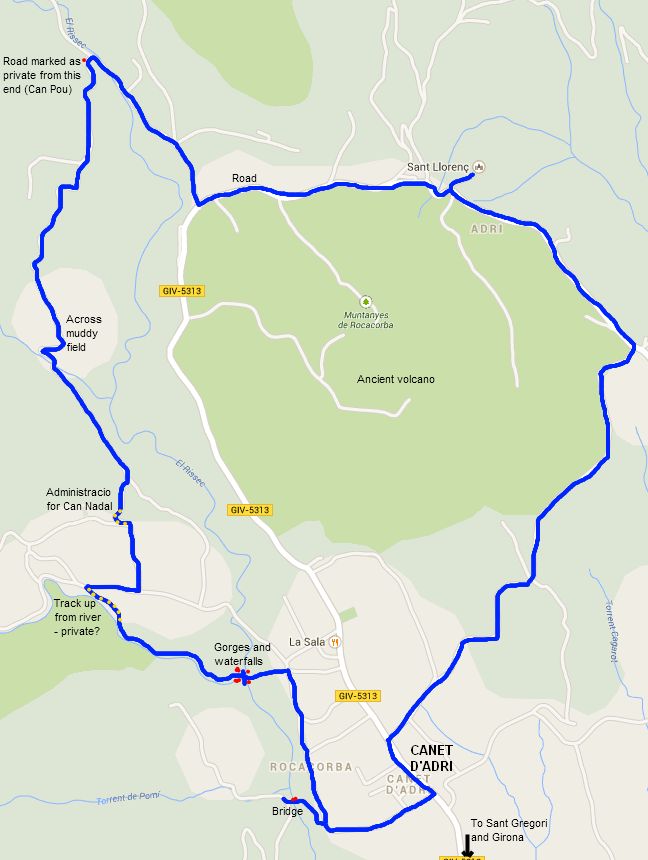
Santa Susanna de Peralta and Sant Climent de Peralta
 Just inland from the main Costa Brava coast, between La Bisbal d'Emporda and Llofriu, just after Vulpellac are the two tiny Peralta hamlets - Santa Susanna de Peralta on one side of the road and Sant Climent de Peralta on the other. Both hamlets are very small, but they extend to include a number of very big, and luxurious, old Masia estates with extensive grounds and stables.
Just inland from the main Costa Brava coast, between La Bisbal d'Emporda and Llofriu, just after Vulpellac are the two tiny Peralta hamlets - Santa Susanna de Peralta on one side of the road and Sant Climent de Peralta on the other. Both hamlets are very small, but they extend to include a number of very big, and luxurious, old Masia estates with extensive grounds and stables.
Santa Susanna is the larger of the two hamlets and was the starting point of walks to Peratallada and to Clots de Sant Julia. It's the site of a now ruined castle that sits behind a restored masia house. Sant Climent, on the other side of the main road is little more than the church, but has a network of roads leading to very large masias into the Gavarres hills. The church looks like the perfect place to start for a walk, but there is just one road and that leads to a big gate for one of the big estates, so you can't go further on.
 This is actually the second attempt at this walk. The first time we got lost and confused as there are many many tracks, particularly as you get into the hills and it can be very difficult to decipher where you are on the map. We park close to the social area for Santa Susanna. This is right next to a set of three traditional haystacks with hay layered around a central pole. These are visible from the main road, so an indication of where to turn if you want to park.
This is actually the second attempt at this walk. The first time we got lost and confused as there are many many tracks, particularly as you get into the hills and it can be very difficult to decipher where you are on the map. We park close to the social area for Santa Susanna. This is right next to a set of three traditional haystacks with hay layered around a central pole. These are visible from the main road, so an indication of where to turn if you want to park.
We walk down the lane and then cross the main road taking care as the cars are fast here. The lane continues on the other side of the road (Cami de Sant Climent), along past the fields with the church of Sant Climant to the left. In early medieval times this would have been a more important area as Sant Climent once boasted a monestary to complement the now ruined castle at Sant Susanna.
The lane continues past a large estate on the right and in the distance we can see snow on the Pyrenees clearly in the bright December light. The masia estates are huge in this area and a searching after the walk I found some of the masias on sale for prices from €5 to €28million.
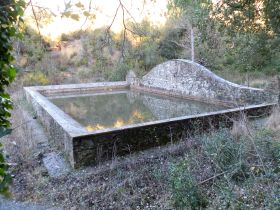 The lane splits at a smaller masia and we take the dirt track to the left rather than follow the tarmac road. The paths are getting a little confusing on the map so we just follow the one main track past a barn and then along the boundary edge of another large estate in the woods. The boundary is marked with very strong keep out and beware of the dogs signs and would be the back of the estate with the private road leading from Sant Climent church.
The lane splits at a smaller masia and we take the dirt track to the left rather than follow the tarmac road. The paths are getting a little confusing on the map so we just follow the one main track past a barn and then along the boundary edge of another large estate in the woods. The boundary is marked with very strong keep out and beware of the dogs signs and would be the back of the estate with the private road leading from Sant Climent church.
The path turns to the left and starts to climb into the hills. As we get higher we can see the Empordan plain spreading out beneath us framed by the mountains in the background. The woods are typical of the Gavarres, all alzina and cork pines. Cork being the main export of this area until the arrival of tourism. We're on the north side of the Gaverres and the ground is moist and leafy - very different in feel to the dry south facing walk above Castell d'Aro last week.
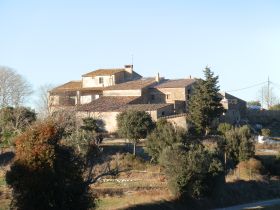 As we get deeper into the woods and closer to the top of the hill we know we need to turn off. The problem though is finding the right path and keeping track of where we are. There are dozens of tracks and routes in this part of the Gavarres, many used for hunting or forestry. If you're familiar with what leads where it is easy to link and follow routes. But when we're in a new part of the woods for the first time it can be difficult to work out how the paths link through the folds and valleys of the hills. We don't get lost in the sense of not being able to get back, but it is easy to get lost in the sense of not finding quite the path we were looking for.
As we get deeper into the woods and closer to the top of the hill we know we need to turn off. The problem though is finding the right path and keeping track of where we are. There are dozens of tracks and routes in this part of the Gavarres, many used for hunting or forestry. If you're familiar with what leads where it is easy to link and follow routes. But when we're in a new part of the woods for the first time it can be difficult to work out how the paths link through the folds and valleys of the hills. We don't get lost in the sense of not being able to get back, but it is easy to get lost in the sense of not finding quite the path we were looking for.
So close to the top of the hill we take a right down a smaller track following the trail of some cyclists (this area is fabulous for rough cycling) and curve around the side of the hill and down to a stream valley. The valley is shaded and chilly in contrast to the sun on the top. We walk down the track following the stream until we emerge by a big stone rectangular man-made pond by a font. After being in the deepest woods it's a surprise to suddenly find an unusual man-made structure.
As we walk past we can now see a masia up to our right. The path continues around the masia and then we get to a chain across the path. It isn't clear if the chain is stopping us going on, or is there to prevent other people coming in our direction. Since we have no obvious alternatives we carry straight on and the track seems to be part of the drive to the masia. At the end is a half open gate and we get back to the main tarmac road near a huge mas slightly elevated above the fields.
 We could take the tarmac road back to where we started but we carry straight on along the gravel track, and then immediately right taking us around the back of the elevated masia. The last time we did this walk, we missed this turning and ended up walking high in to the hills. The track curls around through fields and pieces of woodland. It's easy to follow and quite sandy underfoot.
We could take the tarmac road back to where we started but we carry straight on along the gravel track, and then immediately right taking us around the back of the elevated masia. The last time we did this walk, we missed this turning and ended up walking high in to the hills. The track curls around through fields and pieces of woodland. It's easy to follow and quite sandy underfoot.
As we pass a house to the left we hear the sound of bells like those used for sheep or cows. As we turn the corner we meet a man with a gun and two hunting dogs with bells around their necks. The bells are used to keep track of the dogs in the undergrowth when out hunting boar.
The track is easy and we walk at the back of two more enormous masia estates with swimming pools and stables. The number of horses in this area, it's a surprise there isn't a racecourse nearby.
The path reaches the main road just by the side of the Pordamsa porcelin factory. From the main road this is a grand glass and steel fronted building, but from the side on the track we're on it's a little more plain with a simple red-brick factory type structure.
It would be good if we could avoid the main road, but there are no paths back to Santa Susanna except by walking along the side of the busy route. We turn back up the lane we started from, just taking the time to inspect the strange bricked cave that we ignored on the way out.
Neighbouring walks: Clots de Sant Julia (Vulpellac) - Palau-sator and Peratallada - Llofriu, St Llop and Torrent - Mont-ras to Fitor and on to Fonteta and Vulpellac - La Bisbal, Vulpellac, Castell d'Emporda, Fonteta
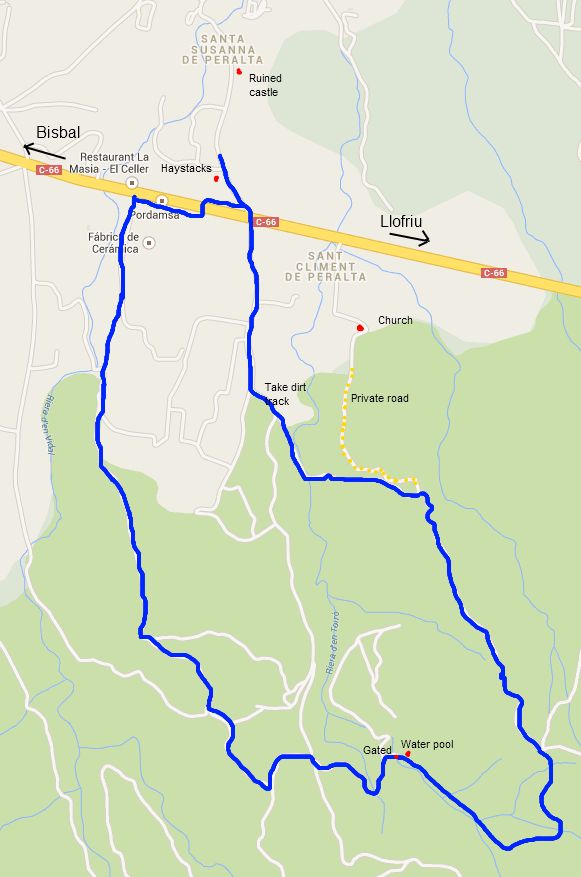
Castell d'Aro and estate of Mas Nou
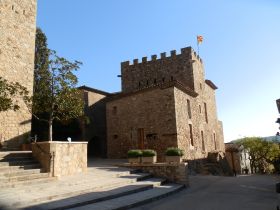 Castell d'Aro is a small Costa Brava town situated at the end of the Aro valley just up from Platja d'Aro on the coast - officially the area is Castell-Platja d'Aro and the village of Castell d'Aro is the older original village centre before the widespread influx of tourism. Being named after a castle, it's no surprise that the town has a small older part with the Castell de Benedormiens located next to the church. The castle is now a museum of dolls (Museu de la Nina).
Castell d'Aro is a small Costa Brava town situated at the end of the Aro valley just up from Platja d'Aro on the coast - officially the area is Castell-Platja d'Aro and the village of Castell d'Aro is the older original village centre before the widespread influx of tourism. Being named after a castle, it's no surprise that the town has a small older part with the Castell de Benedormiens located next to the church. The castle is now a museum of dolls (Museu de la Nina).
The village itself is at the base of the Gavarres and the hills climb to estates at the top that look over the Aro valley as it comes into the Costa Brava from the direction of Llagostera, and out to sea across the bay of Platja d'Aro. The old village centre is relatively small despite the presence of the castle, though well-preserved. Just down from the castle are more modern areas including a train track and one of the old carrilet trains that used to connect Sant Feliu to Guixols to Girona.
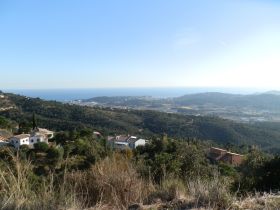 Our aim was to explore the hills and get a glimpse of the views, but it would be fair to say there wasn't much at the top of the hill other than an obstructive golf course and the American-style villa houses.
Our aim was to explore the hills and get a glimpse of the views, but it would be fair to say there wasn't much at the top of the hill other than an obstructive golf course and the American-style villa houses.
Our route starts in the town with a tour of the older parts then heads up the valley to find a right hand link up the hill. It's marked as a white road ont he map, but as we often find, these white routes often turn out to be gravel tracks. We walk up the track and slowly behind us we get views across the valley, out to S'Agaro and the beach at Sant Pol. The day isn't particularly clear for landscape photographs though.
The climb up is steady and the day is surprisingly warm in the sun for December, but there is nothing particularly special about the path and few distractions or other routes off. As we get to the top, the route splits with the bigger track continuing to the left and a smaller track going straight on. We follow the straight on route which flattens out around with a steepish drop and views across the hills. Unfortunately, though it looks as if the track is well used, at the end it is blocked by a gate and fencing surrounding one of the greens of a golf course. The map had shown the route continuing so it's quite a big let down.
 Instead we double back to the nearest clearing and spot red markers and a small semi-overgrown track. We follow the track into the woods and undergrowth and it curves around the upper part of a small valley, arriving at the back of some houses in the Mas Nou estate. The estate has views to the south and down the coast and the high rises of Platja d'Aro are hidden by the curve of the hill. Most of the houses look enormous, built in the style of American estate houses.
Instead we double back to the nearest clearing and spot red markers and a small semi-overgrown track. We follow the track into the woods and undergrowth and it curves around the upper part of a small valley, arriving at the back of some houses in the Mas Nou estate. The estate has views to the south and down the coast and the high rises of Platja d'Aro are hidden by the curve of the hill. Most of the houses look enormous, built in the style of American estate houses.
We're on tarmac now and follow the road path up and along towards the TV-mast. One problem with estates is they tend to curve and run up and down so it can be difficult to spot where the right turning is. We continue around the estate but beyond admiring the gardens, there's not that much to see. So we take the first right and wander back down (looking at the map now, if we'd taken the following right we'd have had a different route down). The road seems to be curling back to our starting point, but we find a track at the bottom and navigate a path, again overgrown and little used, back down the hillside. Eventually we rejoin the path we went up and return back to Castell d'Aro feeling disappointed both by the way the upper path was blocked, but also disappointed by the quality of the walk.
Neighbouring walks: Calonge (Cami de Molins and over Cabanyes) - Platja d'Aro and S'Agaro - Romanya de la Selva - Romanya de la Selva to Puig d'Arques - Solius, rocks for climbing and ruined castle - Platja Sant Pol to Sant Feliu de Guixols - Romanya de la Selva to Platja d'Aro via Golf d'Aro Mas Nou
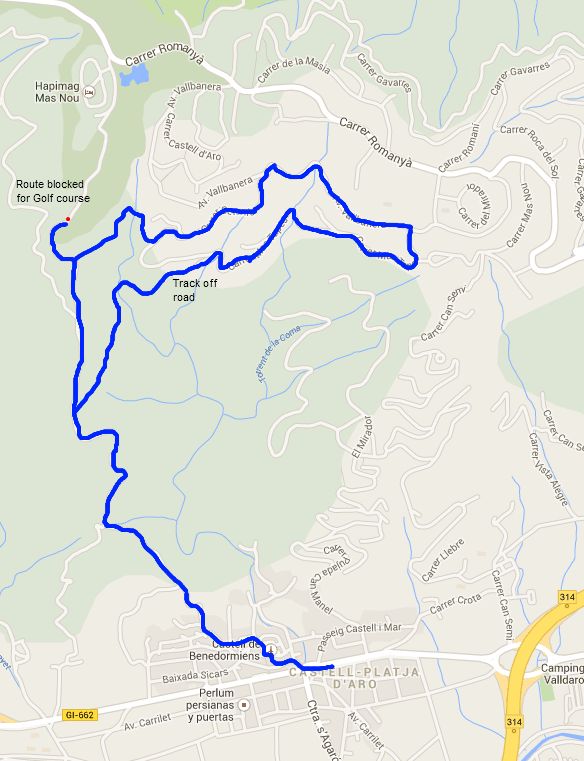
One year of walks and activities
It's now one year since we started this blog. Eighty five things later and we still have more to explore, but hopefully it provides some insight into the rich variety of things to do on the Costa Brava.
We should also note the things we didn't do, or write about - the Festa d'Indianer in Begur in September for instance (it was raining on the Saturday night when we were planning to visit), Carnesoltes/Carneval in Palamos or Platja d'Aro. The Festa de Primavera in Palafrugell - which is like Carnival but Palafrugell doesn't really celebrate the pre-lent festivals, preferring instead its own later 'spring festival'.
And then there were the Festa Majors for the local towns, the Havaneres in Calella de Palafrugell, the music festivals nearby, of which Cap Roig is the most celebrated, and the other local festivals like the circus festival in La Bisbal d'Emporda. And we didn't write up activities like visiting the waterparks or trips to Barcelona. And some weekends, it's just a joy to do nothing, just a local walk. And so on to year two...
Visit to Setcases
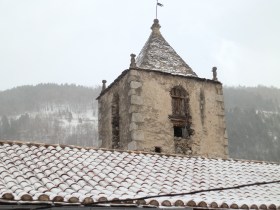 Setcases is a small town/village at the bottom of the valley that leads up to the Valter2000 ski-resort. We like to get at least one trip a year towards the Pyrenees, but it can mean a lot of driving - the actual distance to Setcases is about 120km or about 2 hours drive. But the local snow midweek combined with a need to go to Banyoles for some sports activities gave us the impetus to head towards the mountains to get some proper snow.
Setcases is a small town/village at the bottom of the valley that leads up to the Valter2000 ski-resort. We like to get at least one trip a year towards the Pyrenees, but it can mean a lot of driving - the actual distance to Setcases is about 120km or about 2 hours drive. But the local snow midweek combined with a need to go to Banyoles for some sports activities gave us the impetus to head towards the mountains to get some proper snow.
For skiers, the Costa Brava is relatively close to the mountains and it is feasible to have a day-trip skiing if you're not too worried about longer car journeys. Valter2000 is the closest ski area - resort would be too grand since it is more of a set of lifts and a cafe, with the main inhabited area down at Setcases - a small village a few kilometres on from Campodron.
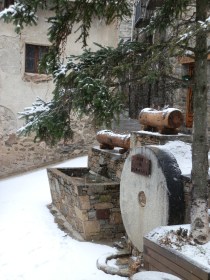 The second closest would be Val de Nuria where you have to catch a train from Ribes de Freser up the mountain to the base station for skiing. Further on still are the Spanish ski resorts of Masella and La Molina, close to Puigcerda. Or you head into the high mountains of Andorra, or across the border into France.
The second closest would be Val de Nuria where you have to catch a train from Ribes de Freser up the mountain to the base station for skiing. Further on still are the Spanish ski resorts of Masella and La Molina, close to Puigcerda. Or you head into the high mountains of Andorra, or across the border into France.
Driving, the roads are relatively easy with dual carriageway all the way to Olot. The exception is the N260 link from Ribes de Freser to La Molina which is very windy and makes travel difficult to the bigger ski-towns near Puigcerda - these are generally easier from Barcelona northwards through the Tunel de Cadi.
Setcases, which translates as seven houses, is in fact bigger than it's name would suggest. The village is along the upper Ter valley from the larger town of Campodron. Campodron is worth visiting for it's museum of the Spanish Civil War and the stories and artifacts from Allied airmen who crashed and crossed the Pyrenees.
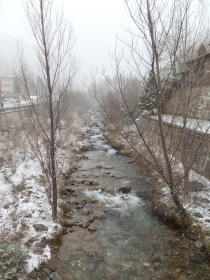 Setcases is then the last habitation before the ski-resort some 10km higher up the valley and sits at 1284m or so. The road up to the top of the valley is very bendy and we weren't prepared for full-on winter driving so Setcases was as a high up the valley as we wanted to go. On the drive we had snow flurries from Campodron, but it wasn't unitl just below Setcases that we reached the base of the snowline, though the road itself was clear.
Setcases is then the last habitation before the ski-resort some 10km higher up the valley and sits at 1284m or so. The road up to the top of the valley is very bendy and we weren't prepared for full-on winter driving so Setcases was as a high up the valley as we wanted to go. On the drive we had snow flurries from Campodron, but it wasn't unitl just below Setcases that we reached the base of the snowline, though the road itself was clear.
So when we parked in the village, snow was turning everything white and there was sufficient on snow on the ground to make for snowball fights. The village is built in a bluff grey stone and feels like a proper mountain village with slate roofs and thick strong walls to the houses. The main village is built on the side of the hill with narrow lanes and streets connecting the terraces of houses and lots of restaurants and the odd hostal/hotel. There's a lot of walking possible in the area including walks up and over the Pyrenees into France or to the local high peaks (all at about 2200m or higher).
Our tour was more modest as we explored the streets and houses. The town has a number of village craft and produce shops selling local honey for instance. A rushing culvert runs alongside the main street and a small church hunkers down just above the rooftops of the main village. The signs suggested that the area was wealthy in older times, both for the pasture nearby, but also for local silver mines.
The snow though was the main reason for the visit. It's always surprising just how easy it is to get a complete change not just of scenery and landscape, but almost of climate just by travelling a couple of hours from the coast.
Other visits: Ribes de Freser and skiing at Vall de Nuria - Puigcerda and Bourg-Madame - Canet d'Adri - Visit to Besalu and Banyoles - Mollo (Camprodon) - Pyrenees to France - Olot - capital of Garrotxa
Snow on the Costa Brava
The general perception in the UK of places in the south of Europe, like the Costa Brava is one of year-round warm temperatures and mild winters, but in reality the weather can get colder. Looking out of the window at the moment and it's snowing. OK, that's big wet soggy snowflakes that aren't settling at the moment, but it's very unusual to have snow close the coast in November.
Snow itself is rare, but not so unusual. In general most years have the possibility of a day's snow and the occasional whiteout during December to February. When we were first looking for somewhere to live here, we arrived just after a snow flurry in February and were walking around Pals with snow on the ground. Generally though the snow doesn't settle, but if you we're close enough to the Pyrenees to be able to head to the mountains for a day to get a full winter experience.
The general winter situation is that nights are cold, but days can be bright and sunny and it can be sunny enough to keep a house warm without needing heating during the daylight. As it gets colder in the evenings many people just use a simple fire for warmth, rather than turn to full heating, at least until the deeper winter. So a piece of advice for anyone visiting during the winter period eg over Christmas, is to check whether the house or villa has central heating.
Empuries Greek and Roman remains
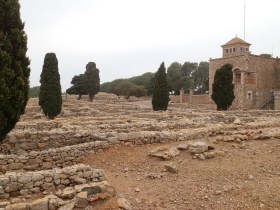 Situated just north of L'Escala, right on the coast itself are the ancient remains of the Greek and Roman towns of Empuries, the major port of the Costa Brava coast in the Ancient world, and along with Barcelona and Tarragona, one of the main Catalan Roman cities.
Situated just north of L'Escala, right on the coast itself are the ancient remains of the Greek and Roman towns of Empuries, the major port of the Costa Brava coast in the Ancient world, and along with Barcelona and Tarragona, one of the main Catalan Roman cities.
We'd seen the ruins from the sea-facing side walking between L'Escala and Sant Marti d'Empuries - a very pleasant Sunday afternoon stroll. What we hadn't realised until this year was the extent of the ruins on the other side. Only when we were returning from Cinc Claus on the walk from Escala, St Marti d'Empuries and beyond did we really start to get an impression of the size of the site.
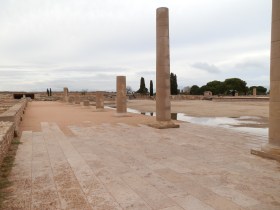 The whole site has now been dedicated as an archeological site with a modern museum with entrance only €3 for adults and free for children and we were allowed to take in our dog on a lead. What's initially surprising is that Empuries actually consists of two distinct towns. Prior to visiting I was under the impression that the Greeks came first and then their village was taken over by the Romans. In fact the Roman Empuries is distinctly separate from the older Greek part.
The whole site has now been dedicated as an archeological site with a modern museum with entrance only €3 for adults and free for children and we were allowed to take in our dog on a lead. What's initially surprising is that Empuries actually consists of two distinct towns. Prior to visiting I was under the impression that the Greeks came first and then their village was taken over by the Romans. In fact the Roman Empuries is distinctly separate from the older Greek part.
The history of the site is that it was first created as an outpost of the Phoenician's and then became a Greek colony and port trading inland with the neighbouring Iber tribes and villages (Empuries and Emporium as a shop share the same derivation). The Greek's travelled throughout the Mediterranean and had colonies in places like Sicily (Syrakuse). The Greek ruins run up the hill and there is a temptation to imagine a white walled village like Mykanos on the side of the Catalan Coast.
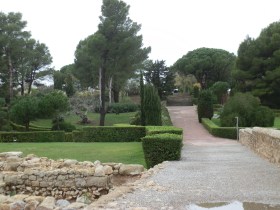 For this visit though, we visited the Roman part first. This is marked by a long straight wall of about 300m in length, and surprisingly the wall is hollow - there would have been enough space for someone to walk through the middle. On the outside of the wall was the ampitheatre and stadium training ground, while the remaining parts of the town stood inside the walls. The Roman town itself was built within a rectangle with straight streets in a modern block arrangement.
For this visit though, we visited the Roman part first. This is marked by a long straight wall of about 300m in length, and surprisingly the wall is hollow - there would have been enough space for someone to walk through the middle. On the outside of the wall was the ampitheatre and stadium training ground, while the remaining parts of the town stood inside the walls. The Roman town itself was built within a rectangle with straight streets in a modern block arrangement.
Entering through the gate on the main wall, you walk down what would have been a main street where there would have been shops and traders. The stone flaggons on the floor still show the ruts from carts that would have passed through. At the end of this street is the main forum - the main town square. To help visitors, part of some of the buildings have been rebuilt and stone columns re-erected to give a sense of the town. Past the forum are the remains of the ancient baths and what would have been two or three large villas. Although many of the ruins have been excavated but there is still a large area to be explored.
 We then walked down the hill to the start of the Greek village built 500 years before the Romans arrived. While the Roman part was laid out in a regular fashion, the Greek city is much more higgedly piggedly with houses and spaces seemingly on top of each other. I always find it difficult to construct an image of a town or buildings just from their foundations, but even so it's very clear how large the town would have been. The Greek part also had it's own square and temple and area dedicated as a 'health resort'. The main Greek walls are at the bottom of the hill.
We then walked down the hill to the start of the Greek village built 500 years before the Romans arrived. While the Roman part was laid out in a regular fashion, the Greek city is much more higgedly piggedly with houses and spaces seemingly on top of each other. I always find it difficult to construct an image of a town or buildings just from their foundations, but even so it's very clear how large the town would have been. The Greek part also had it's own square and temple and area dedicated as a 'health resort'. The main Greek walls are at the bottom of the hill.
The site also has a modern museum where you can see artifacts. If anything we were slightly surprised at how little there was in the museum given the size of the main site. It is possible that much of the town was plundered when it was abandoned for Sant Marti in the early post-Roman era.
The geography of the site is also interesting in that when the Greeks and Romans were living in Empuries, the sea was a lot farther inshore. The ancient port wall that can be seen on the beach below Empuries would have protected a harbour inside the wall, where the beach is now (suggesting a sea level 3-4m higher than it is at present). In fact the sea was sufficiently high that neighbouring Sant Marti was an off-shore island at the time. Changes to sea-level combined with silting and shifting of the river Fluvia essentially rendered Empuries obsolete as a port, but it is interesting that there are so many Roman ports on the Mediterranean (eg Ephesus, Portus, Carthage, Frejus) which are now dry or a long way from the sea.
Neightbouring walks: Escala, St Marti d'Empuries and beyond - L'Escala Riells to sea cliffs and viewpoint of Montgo - Aiguamolls d'Emporda (Empuriabrava)
Torroella de Montgri to Gola de Ter
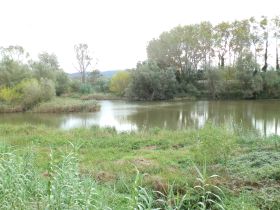 The river Ter is one of the major rivers for Baix Emporda and a defining feature of the Costa Brava geography. The river rises in the Pyrenees at Valter 2000 - the closest ski-resort runs down through the Plana de Vic, past Girona and then out to the sea at L'Estartit just past Torroella de Montgri.
The river Ter is one of the major rivers for Baix Emporda and a defining feature of the Costa Brava geography. The river rises in the Pyrenees at Valter 2000 - the closest ski-resort runs down through the Plana de Vic, past Girona and then out to the sea at L'Estartit just past Torroella de Montgri.
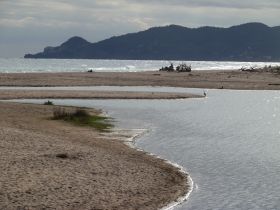 In the early middle ages, Torroella de Montgri was one of the main towns of Emporda and a royal port by virtue of the River Ter. Over time the port at Torroella silted up (and possibly sea levels dropped) restricting sea access from the town to L'Estartit and so in medieval times, the main royal port of the Costa Brava moved south to Palamos. However Torroella remains in many ways a medieval town with narrow streets and the vesitages of its castle, church and town walls. As with many older Catalan towns, the inner streets are too narrow for vehicles, so it is easy to drive past without appreciating the town inside, though it isn't a pretty-pretty town as such.
In the early middle ages, Torroella de Montgri was one of the main towns of Emporda and a royal port by virtue of the River Ter. Over time the port at Torroella silted up (and possibly sea levels dropped) restricting sea access from the town to L'Estartit and so in medieval times, the main royal port of the Costa Brava moved south to Palamos. However Torroella remains in many ways a medieval town with narrow streets and the vesitages of its castle, church and town walls. As with many older Catalan towns, the inner streets are too narrow for vehicles, so it is easy to drive past without appreciating the town inside, though it isn't a pretty-pretty town as such.
 For the walk we parked outside the main auditori (Espai Ter) in Torroella and walked down to the river by Carrefour. The bank is quite high above the river, reflecting the potential for the Ter to flood - though flooding is much more controlled now with the dams in the higher reaches. The river is broad and natural with willows at the river level and the occasional heron on the bank. Up on the path we're flanked on one side by fruit orchards and then occassional groves of wild bamboo that block the view to the river. The path is a broad gravel track and we pass the odd car parked by one of the small horta (allotments) that sit between the fruit trees.
For the walk we parked outside the main auditori (Espai Ter) in Torroella and walked down to the river by Carrefour. The bank is quite high above the river, reflecting the potential for the Ter to flood - though flooding is much more controlled now with the dams in the higher reaches. The river is broad and natural with willows at the river level and the occasional heron on the bank. Up on the path we're flanked on one side by fruit orchards and then occassional groves of wild bamboo that block the view to the river. The path is a broad gravel track and we pass the odd car parked by one of the small horta (allotments) that sit between the fruit trees.
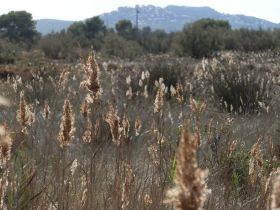 The walk is otherwise unremarkable, though it's good to walk by a river in contrast to the coast or in among the woods. Ahead of us we can see the islands of the Islas Medes which, because we can't yet see the sea, look like odd shaped mountains rising above the land level.
The walk is otherwise unremarkable, though it's good to walk by a river in contrast to the coast or in among the woods. Ahead of us we can see the islands of the Islas Medes which, because we can't yet see the sea, look like odd shaped mountains rising above the land level.
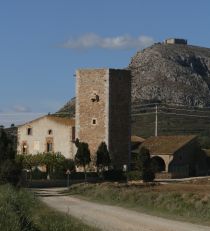 After a while the river passes an island then continues to widen almost looking like a small lake as we approach the Gola or mouth of the river. The river itself is big enough to cut through the beach all year around so it's not possible to cross to the beach on the other side without swimming and the natural flow of the river and action of the waves where the river meets the sea at the beach of Platja de Pals leaves sandbanks on the beach that change shape from one visit to the next. The fresh water of the river-lake is also a huge attraction for our dog who just loves jumping in the water then sprinting around on the sand. The light here for photography is often superb with the castle at Montgri, reeds, birds the sea and the islands as a backdrop.
After a while the river passes an island then continues to widen almost looking like a small lake as we approach the Gola or mouth of the river. The river itself is big enough to cut through the beach all year around so it's not possible to cross to the beach on the other side without swimming and the natural flow of the river and action of the waves where the river meets the sea at the beach of Platja de Pals leaves sandbanks on the beach that change shape from one visit to the next. The fresh water of the river-lake is also a huge attraction for our dog who just loves jumping in the water then sprinting around on the sand. The light here for photography is often superb with the castle at Montgri, reeds, birds the sea and the islands as a backdrop.
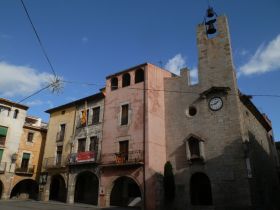 As we're on the north side of the Gola de Ter, we head along the beach towards L'Estartit but only for a short while. After a couple of hundred metres we turn across the sands and into the Aiguamolls de Baix Ter - sea marshes in among the dunes - a different type of landscape, though a little rough and ragged. We continue back out into the fields and farms that are spread across the area towards Torroella, picking out a route past the fruit trees - most of which have been harvested by now.
As we're on the north side of the Gola de Ter, we head along the beach towards L'Estartit but only for a short while. After a couple of hundred metres we turn across the sands and into the Aiguamolls de Baix Ter - sea marshes in among the dunes - a different type of landscape, though a little rough and ragged. We continue back out into the fields and farms that are spread across the area towards Torroella, picking out a route past the fruit trees - most of which have been harvested by now.
Our route takes us past one of the Torres (Towered old Masias) and then back into Torroella past one of the industrial estates. We explore the town briefly as most of the shops are shut for lunch. Torroella has grand hotel in the former castle just next to the church with jazz playing in the garden. The streets themselves are on a grid system and quite narrow and slightly claustrophic, but with the odd square with arcades in the centre. Torroella is also the site of the Museu del Mediterrani - another attraction to visit another day.
Neighbouring walks: L'Estartit to Cala Pedrosa and Cala Ferriol - Torroella de Montgri castle - Gualta, Llabia, Fontanilles and the lake of Ullastret - Pals beach to Gola de Ter
Swimming at Gola del Ter (Pals/L'Estartit) or L'Estartit
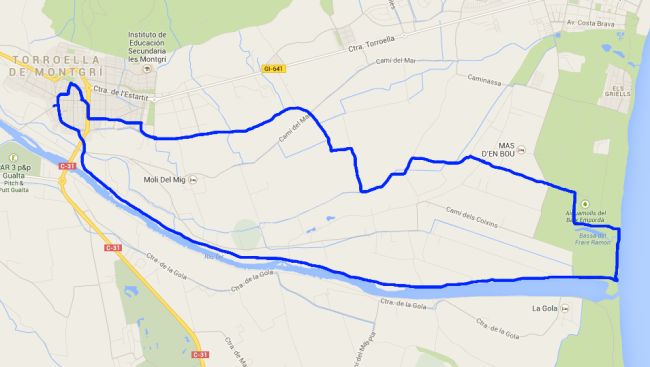
Comments | ||
adam@veggingoutwithadam.com |
17 Feb 2014 19:46 |
|
What a great blog. I am planning a walking holiday in the region and wonder if you can recommend the best walking maps, like UK ordnance survey ones. I shall be reading more of your walks over the coming days as we plan. Many thanks Adam | ||
Saul |
24 Feb 2014 17:25 |
|
Glad you're enjoying it. We have recommendations for maps in our 'Advice and FAQ' section | ||
Saul |
13 Jul 2017 12:46 |
|
Sorry I missed the comment, so I hope it's not too late - use the contact box if you'd like to send a message. For the coast, the GR92 is best and if you have driver you can just take it piece by piece. For hikers, around Cap de Creus is great, though it can be dry and hard walking in summer. For us, the stretch between Palamos and Palafrugell and on to Begur is the prettiest part of the whole Costa Brava and really good for walking. I'd probably also take the walk up and over Montgri, possibly starting at Pals, or L'Estartit to L'Escala. And though you said you prefer the coast, don't overlook inland routes as there are some wonderful villages and countryside out towards Girona, La Bisbal, or Olot. | ||
Sven-Gunnar Furmark |
24 May 2017 11:43 |
|
Hi, My name is Sven Furmark. I am from Sweden. I plan to go to Costa Brava with some friends (totally about 10 people) for hiking for one week (5 walking days). We are experienced hikers and we usually walk 4-6 hours per day. We prefer to walk along the coast as much as possible. We plan to rent a house and travel to each days hiking with a bus & driver which we plan to book for the whole week. Which five hikes would you recommend for us. Warm Regards Sven | ||

